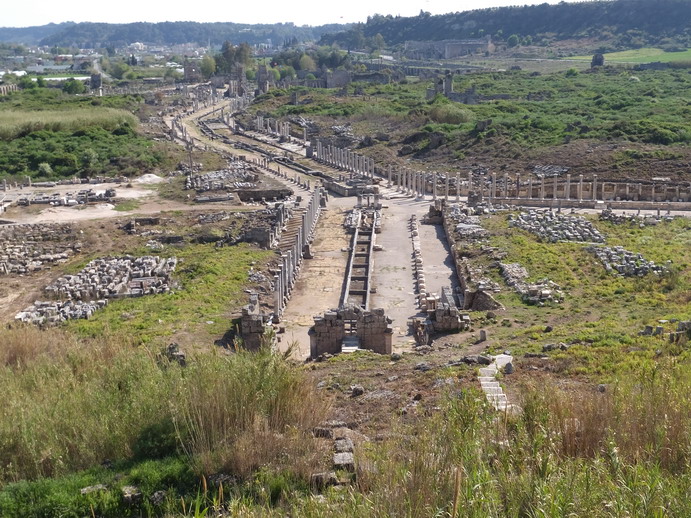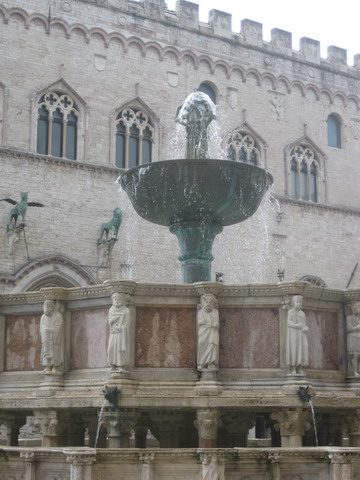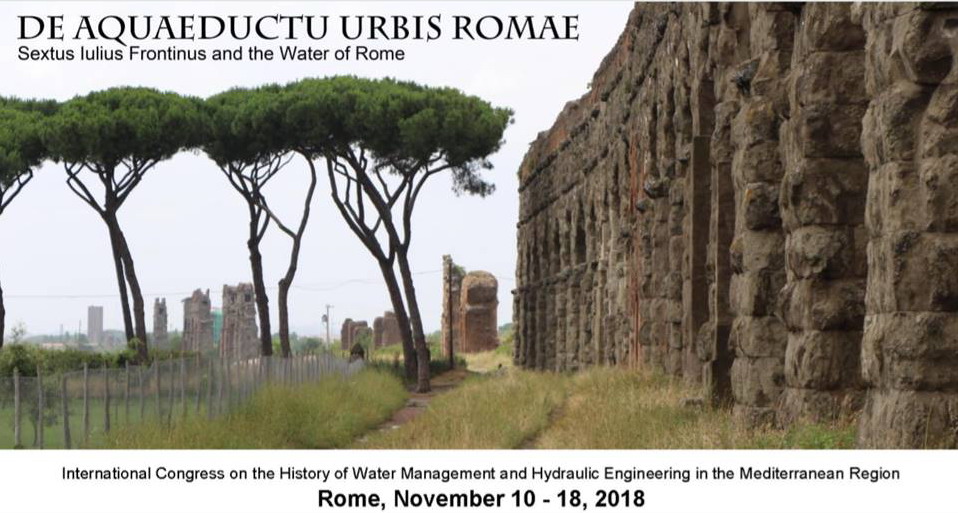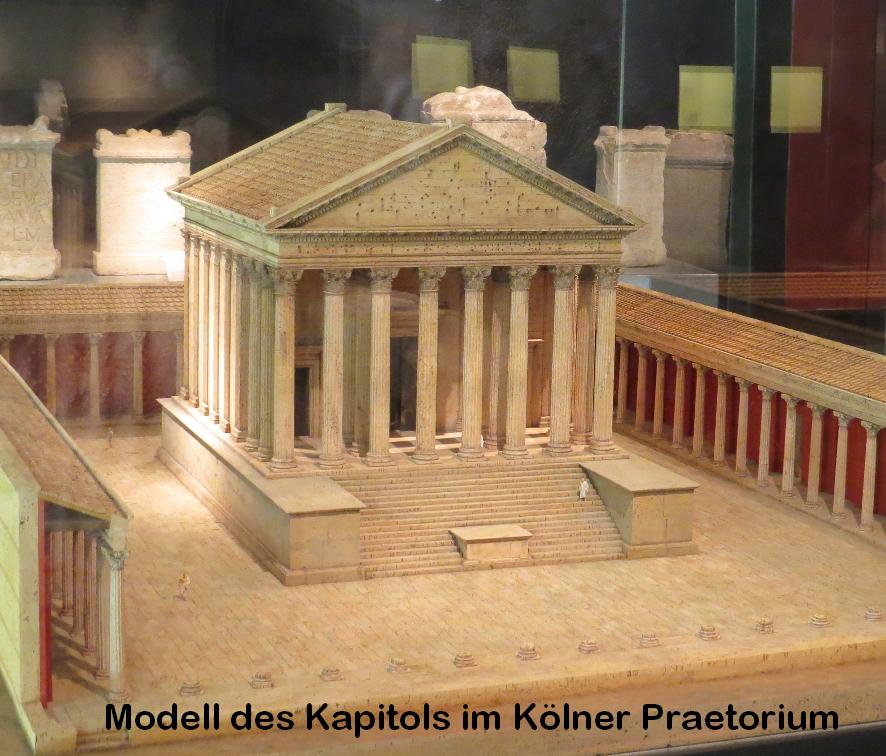Events
Archive
Thursday, 13.06.2024 6:00 pm (CET)
Online-Lecture Dr. Hubertus Manderscheid - Einst und jetzt - Standard und Luxus des Warmbades in römischer Zeit
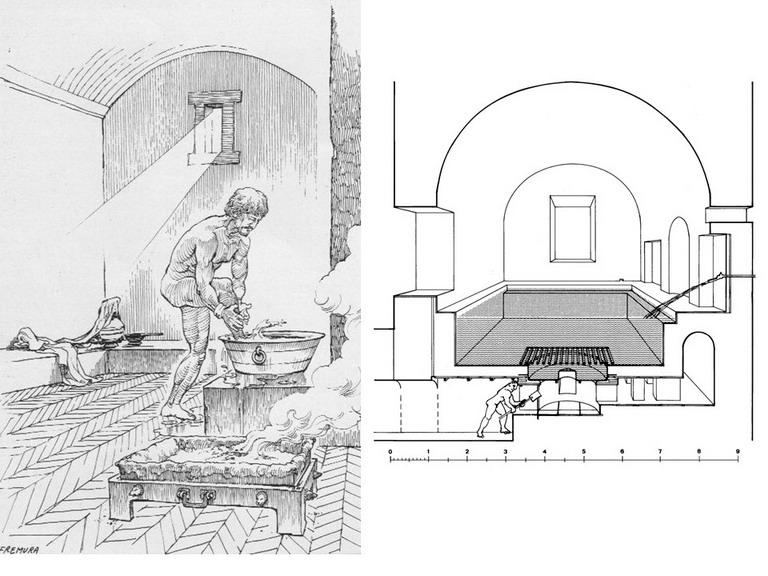
Cordial Invitation
to the Online Lecture (ZOOM) on 13.06.2024, 6:00 pm (CET)
Dr. Hubertus Manderscheid
"Einst und jetzt" - Standard und Luxus des Warmbades in römischer Zeit
("Once and now" - the standard and luxury of warm baths in Roman times)
(Lecture in German)
Picture: The comparison between past and present
Hubertus Manderscheid is a freelance archaeologist. He completed his doctorate at the University of Cologne in 1977. He lived in and near Rome since 1978. Two of his main areas of work are the architecture, decorative furnishings and hydro- and heating technology of ancient baths as well as Roman "water archaeology". He has published a number of major and minor articles on these topics (Rome, Ostia, Pompei, etc.). His most recent monograph (2020) deals with "Water management, hydrotechnology and water architecture of Minturnae", and his current work on "Air conditioning of residential and representational architecture in Rome and Latium" is about to be published. He is a corresponding member of the German Archaeological Institute and was awarded the Frontinus Medal in 2018.
Hubertus Manderscheid about his lecture:
Both the written sources and the archaeological findings document the development of Roman bathing from a simple "washbasin" for physical cleansing, mainly with cold water, to the "heated swimming pool", the ultimate in Roman bathing culture. The invention of the hypocaust heater and its use in bathing contexts was of decisive importance. It not only helped to heat the spa rooms, but also revolutionised the way water was heated. A standard gradually developed that is reflected in countless bathing facilities. A second factor had major consequences for the bathing industry: the increased construction of long-distance pipelines, which transported a considerable, constant volume of high-quality water to numerous cities in the Roman Empire day-to-day. This made it possible to build larger baths and at the same time increase the number and dimensions of the bathing pools, including the boilers for heating the water. In this way, more and more people were able to enjoy bathing. In the end, thermal bath architecture and technology had an influence on the social life of the Romans that should not be underestimated. The facilities that highlighted from this standard, which was intended for the masses, were those that offered something "more", namely the luxury of a heated piscina.
The access data for the online meeting (ZOOM) are as follows:
https://us02web.zoom.us/j/87933930044?pwd=dlk4REZ4S0NnL3k2RGN2TVdtZTd3Zz09
Meeting-ID: 879 3393 0044
Kenncode: 631844
The invitation as a document you can download here .
Friday, 31.05.2024
Thursday, 16.05.2024 6:00 pm (CET)
Online-Lecture Dr. Natalie de Haan - Under Construction - the Central Baths at Pompeii, 16.05.2024

Cordial Invitation
to the Online Lecture (ZOOM) on 16.05.2024, 6:00 pm (CET)
Dr. Natalie de Haan
"Under Construction - the Central Baths at Pompeii"
(Lecture in English)
Picture: The palaestra of the central thermal baths in Pomeji
(photo N. de Haan)
Nathalie de Haan studied Ancient Languages and Classical Archaeology in Nijmegen, where she completed her doctorate in 2003 with a dissertation on Roman private baths. From 2000-2006 she was a research officer for archaeology and ancient history at the Koninklijk Nederlands Instituut in Rome (KNIR) and initiated the research project on the "Terme Centrali" in Pompeii together with Kurt Wallat. Since 2006 she works at the Radboud University Nijmegen as a teacher and researcher for Ancient History (RICH - Radboud Institute for Culture and History). Her research focusses on Roman bathing culture, the Flavian period in Rome and the history of ancient studies in Italy.
Natalie de Haan about her lecture:
When Mt. Vesuvius erupted in 79 AD, the Central Baths were still under construction. As a consequence, these large public baths were never used. Their unfinished state provides us with a unique opportunity to learn more about the original design of the baths, dating to the early Flavian age. Hardly any other public bath building of the same period has survived in its original lay-out. The fact that the Central Baths remained unfinished offers the possibility to study building processes, the division of labour and the sequence of the work. Moreover, the Central Baths were designed and built in a crucial period in the history of Roman baths and bathing culture. Had the Central Baths been finished, they would have offered the inhabitants and visitors of Pompeii a completely new bathing experience, due to the perfection of the planned (and partially completed) facilities.
The access data for the online meeting (ZOOM) are as follows:
https://us02web.zoom.us/j/87933930044?pwd=dlk4REZ4S0NnL3k2RGN2TVdtZTd3Zz09
Meeting-ID: 879 3393 0044
Kenncode: 631844
The invitation as a document you can download here .
Thursday, 11.04.2024 6:00 pm (CET)
Online-Lecture Michael Deniz Yilmaz, PhD - The Joining and Laying of Stone and Clay Pipes in Inverted Siphon Systems
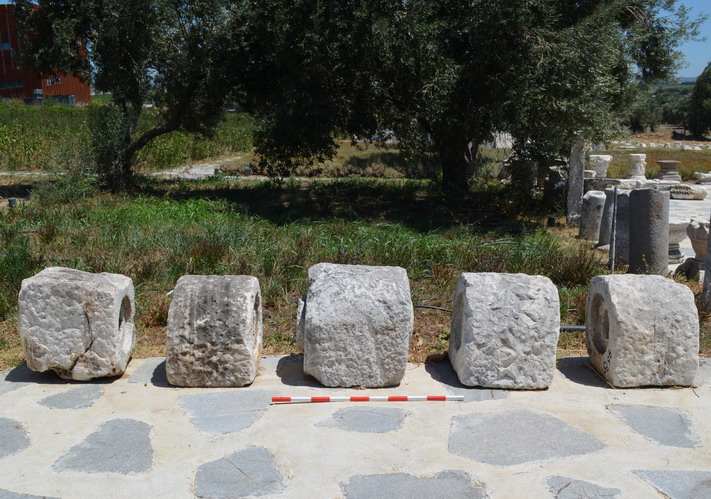
Cordial Invitation
to the Online Lecture (ZOOM) on 11.04.2024, 6:00 pm (CET)
Michael Deniz Yilmaz, PhD
The Joining and Laying of Stone and Clay Pipes in Inverted Siphon Systems
(Lecture in English)
Picture: Inverted Siphon Elements of Parion at
Çanakkale Museum (Photo: Michael D. YILMAZ)
Michael D. Yilmaz, completing his BA at Ankara University Archaeology Department (2012), MA at Ondokuz May?s University Archaeology Department (2015) and PhD at Atatürk University Classical Archaeology Department (2021) is working at Ondokuz May?s University as a research assistant since 2014. He has participated in several projects at ancient sites in Turkey, namely: Zeugma (Gaziantep/Nizip - 4 years), Karain Cave (Antalya/Dö?emealt? - 2 years), Parion Excavations (Çanakkale/Biga - 8 years), Dombalaktepe Mound (Samsun/Atakum - 2 years) and finally Akalan Citadel (Samsun/Atakum - 2 years). Since 2022 he has been directing the ongoing project titled “Akalan Citadel and Environs (Samsun) Archaeological Survey”.
Michael D. Yilmaz’s research areas span from Roman legions and military equipment, to aqueducts and ancient hydraulics, as well as Black Sea archaeology. His thirst for learning more about ancient hydraulics began with his PhD studies which concluded with the dissertation titled “Aqueducts of Parion (Supply-Distribution-Discharge)”.
Michael Deniz Yilmaz about his lecture:
Pipes a necessity of the inverted siphon systems for Roman Aqueducts are known to have been made of (baked) clay, stone and lead. This presentation aims to introduce the already known information regarding the laying and joining of the stone and clay pipes for the production of inverted siphon systems, which has mostly been conveyed to us by ancient authors such as Vitruvius, Plinius and Palladius as well as modern researchers. Further information and insight into the already known information will be shared relating to the diverse and intriguing aspects of the application of pipes in inverted siphon systems during the Roman Age with field experiences and observations made during the studies for the PhD dissertation titled “Aqueducts of Parion (Supply-Distribution-Discharge)”.
The access data for the online meeting (ZOOM) are as follows:
https://us02web.zoom.us/j/87933930044?pwd=dlk4REZ4S0NnL3k2RGN2TVdtZTd3Zz09
Meeting-ID: 879 3393 0044
Kenncode: 631844
The invitation as a document you can download here .
Thursday, 14.03.2024 6:00 h (CET)
Online-Lecture Prof. Dr. Inge Uytterhoeven - Bathing in a Private Setting, 14.03.2024
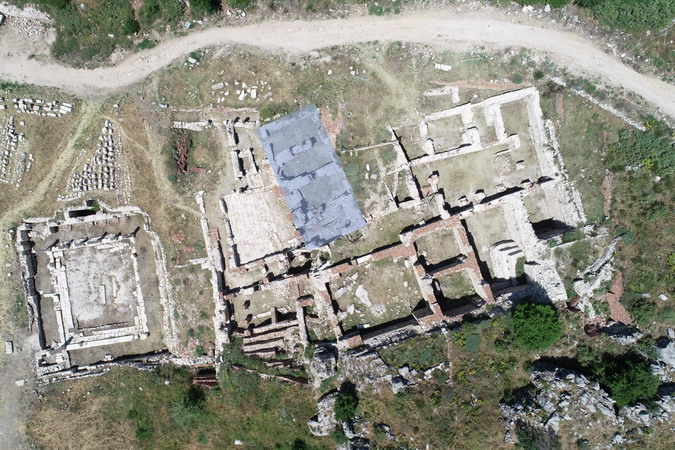
Cordial invitation to the lecture of
Prof. Dr. Inge Uytterhoeven
„Bathing in a Private Setting
Baths as Reception Spaces in the Roman and
Late Antique Elite Houses of Asia Minor“
14.03.2024, 18.00 Uhr (MEZ)
(Online-ZOOM, Lecture in English)
Aerial picture of the “Urban Mansion” at Sagalassos with indication
of the private bath complex in blue (© Sagalassos Archaeological
Research Project)
Inge Uytterhoeven is a Full Professor in the Department of Archaeology and History of Art and an Associate Dean of the College of Social Sciences and Humanities at Koç University in Istanbul. After her studies in Ancient Greek and Latin Language and Literature and Archaeology at KU Leuven (Belgium – 1991–1998), she obtained her PhD in Archaeology in 2003 from the same university with a dissertation on the Graeco-Roman village and necropolis of Hawara in the Egyptian Fayum (published in 2009). Her research integrates material and written evidence and focuses on housing, public architecture, and broader urban studies in Hellenistic, Roman, and Late Antique Anatolia, and the Eastern Mediterranean. She has worked on archaeological sites in Belgium, Italy, Greece, Egypt, and especially Turkey, where she has been part of field research at Sagalassos (A?lasun, Burdur – KU Leuven project) and Limyra (Finike, Antalya – Austrian Archaeological Institute project) since many years.
Inge Uytterhoeven about her lecture:
As crucial elements of guest reception in Roman and Late Antique houses, private baths took a central place in the lives of the ancient well-to-do. Provided with sophisticated heating and water systems and embellished with lavish décor, they formed the stage where the ancient elite host would receive his guests before receiving and entertaining them at the evening banquet.
Starting from examples known from Roman and Late Antique Asia Minor, including the private baths investigated during our fieldwork in the Pisidian city of Sagalassos, this paper looks into the role private baths played in the houses of the urban elites. It discusses how private baths modelled after "Roman" baths in Italy appeared in Asia Minor in the early Roman Imperial period and how they developed into extended complexes with rich ornamentation in Late Antiquity. The presentation will especially focus on the functioning of private bath suites within the context of receiving visitors in the residences and pay attention to the different users of the houses who had access to the private baths, including the host, his relatives, and his guests, as well as the personnel that contributed to making bathing in a private setting a pleasant experience.
The access data for the online meeting (ZOOM) are as follows:
https://us02web.zoom.us/j/87933930044?pwd=dlk4REZ4S0NnL3k2RGN2TVdtZTd3Zz09
Meeting-ID: 879 3393 0044
Kenncode: 631844
The invitation as a document you can download here .
Thursday, 11.01.2024 6:00 pm (CET)
Online-Lecture Dr. Matthias Nieberle - Die Wasserleitung von Vindonissa -The Vindonissa aqueduct, 11.01.2024
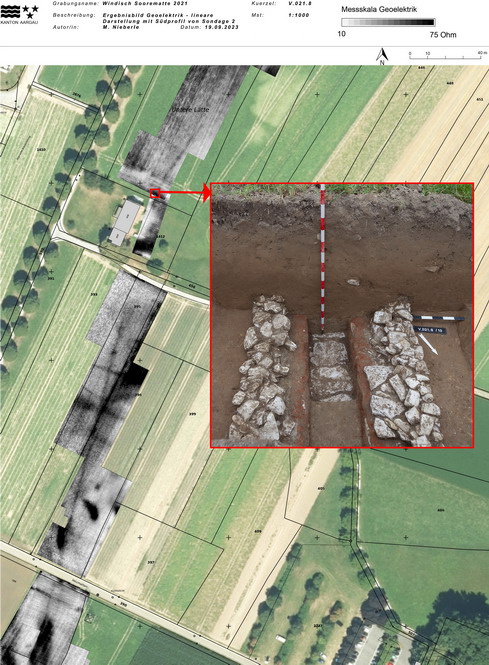
Cordial invitation to the lecture of
Dr. Matthias Nieberle
„Die Wasserleitung von Vindonissa“
(„The Vindonissa aqueduct“)
on 11.01.2024, 6:00 pm (CET)
Online (ZOOM, Lecture in German)
Result image of the geophysical prospection with image of
a localisation of the so-called "dead" aqueduct of Windisch
Matthias Nieberle studied Classical Archaeology, Ancient History and Medieval and Modern History at the Universities of Augsburg, Bern and Cologne. During his studies, he took part in excavations and numerous geophysical prospection projects in Germany and other countries, some of which he directed, and worked as a research assistant at the DAI in Rome, among other places. His doctoral thesis entitled: "Baiae. Genesis, use and function of a Roman bath and spa centre" was successfully defended this year. Since 2020 he has been working for the Cantonal Archaeology of Aargau (CH) and is mainly responsible for geophysical prospections. His research interests include Roman bathing, ancient water supply and sewage disposal as well as ancient urbanism and architecture.
Matthias Nieberle about his lecture:
Vindonissa (Windisch, CH) was the sole permanent legionary camp in Switzerland and was occupied from around 14/16 to 101 AD. An essential and vitally important installation for the approximately 5,500 soldiers in the camp was a sufficient supply of drinking water. This was ensured by two aqueducts, which transported the precious water from the area south of Vindonissa, today's Hausen and Lupfig, to the legionary camp. To this day, the chronologically presumably younger aqueduct, which is around 2.4 kilometres long, still carries water until today. The presumably older aquaeduct, which is around 3.1 kilometres long, is no longer functional and is therefore referred to as a "dead" aquaeduct. The precise route of this "dead" and largely underground water pipe was only vaguely known in some sections. In 2021, one such section was prospected using geophysical measurements and subsequently localised using an excavator. The lecture introduces the water supply of the legionary camp of Vindonissa, explains the main features of the geophysical prospection and reports on the measures taken to locate this previously unknown section of pipeline.
The access data for the online meeting (ZOOM) are as follows:
https://us02web.zoom.us/j/87933930044?pwd=dlk4REZ4S0NnL3k2RGN2TVdtZTd3Zz09
Meeting-ID: 879 3393 0044
Kenncode: 631844
The invitation as a document you can download here .
Thursday, 07.12.2023 6:00 pm (CET)
Online-Lecture Lic. Phil. Regula Wahl-Clerici - The water supply system in the Roman gold mine of Tresminas: challenges and questions, 07.12.2023
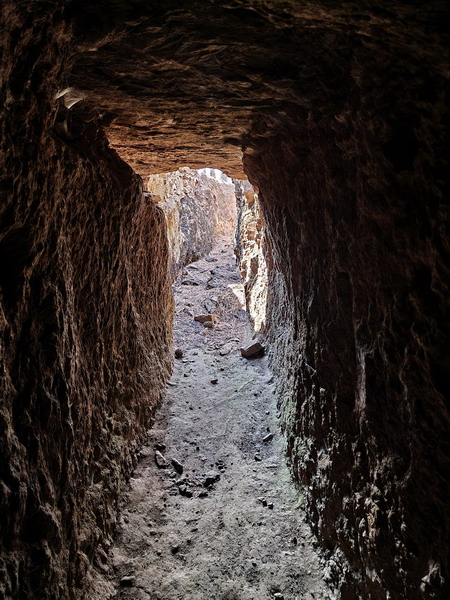
Cordial invitation to the lecture of
Lic. Phil. Regula Wahl-Clerici
„Das Wasserzufuhrsystem im römischen Goldbergwerk von Tresminas: Herausforderungen und Fragestellungen“
(„The water supply system in the Roman gold mine of Tresminas:challenges and questions“)
on 07.12.2023, 6:00 pm (CET)
Online (ZOOM, Lecture in German)
Pedroso tunnel
Regula Wahl-Clerici studied prehistory and early history, general history and art history at the University of Zurich. At the same time, she worked at the Cantonal Monument Preservation Office in Zurich, where she became increasingly interested in Roman antiquity. After moving to Madrid, she researched Roman mining on the Iberian Peninsula together with her husband Jürgen Wahl ( died 2007). The first visit to the Roman gold mine of Tresminas (1985) already showed the potential of this monument, although only a small part of it was known. In the mining zone, which was first mentioned in the 18th century, important evidence of prospecting, mining and processing has been preserved in all its aspects. Of particular interest is the water supply system, which has been systematically researched since 1991 and is being prepared for another volume of the Tresminas monographs.
To the present, Regula Wahl-Clerici continues her research in the territorium metallorum Tresminas/Jales. In addition to the annually published essays on various aspects of ancient mining and hydraulic engineering and a trilingual overview of the site, the monograph „Roman Gold from Portugal (Tresminas): Prospection - Mining – Treatment“ as volume 3.1 in the „Beiträge zur Technikgeschichte“ of the „Dr. h.c. Alfred Mutz-Stiftung für alte, insbesondere antike Technologie und Technikgeschichte“ (Basel), which was published in English (2020) and Portuguese (2021).
Regula Wahl-Clerici about the lecture:
Gold was mined on an industrial scale in the territorium metallorum Tresminas / Jales in the 1st and 2nd centuries AD. In addition to the monuments of mining in the primary deposit and ore processing, the remains of a complex water supply system have also been preserved.
One challenge was and still is the documentation of this system, a process that took decades. Although important evidence of hydraulic engineering has been preserved, the destruction caused by agriculture, forestry and settlements mainly affects the routes of the twelve water pipes. Of particular interest, in addition to the various catchments and diversions, are the constructions through which additional water was channelled into a passing aqueduct. The three qanat tunnels - all other tunnels and galleries in the mining area were not qanats - meant that the course of the respective aqueducts could be significantly shortened.
The purpose for which the water was supplied and the chronological classification of the various pipes in this system, which was built at enormous expense, have not yet been conclusively clarified - except in two cases.
The presentation will use selected examples to illustrate these various aspects of the system.
The access data for the online meeting (ZOOM) are as follows:
https://us02web.zoom.us/j/87933930044?pwd=dlk4REZ4S0NnL3k2RGN2TVdtZTd3Zz09
Meeting-ID: 879 3393 0044
Kenncode: 631844
The invitation as a document you can download here
Thursday, 09.11.2023 6:00 pm (CET)
Online-Lecture Dr. Julian Hollaender - River pictures and townscape in Perge
Cordial invitation to the lecture of
Dr. Julian Hollaender
„Flussbilder und Stadtbild in Perge“
(„River pictures and townscape in Perge“)
on 09.11.2023, 6:00 pm (CET)
Online (ZOOM, Lecture in German)
Julian Hollaender studied Classical Archaeology, Ancient History and Political Science in Munich. In his dissertation "Der fließende Gott - Bilder von Flüssen und ihren Göttern in der römischen Kaiserzeit“ („The flowing god - Images of Rivers and their Gods in the Roman Imperial Period"), he looked at the iconographic and aesthetic-semantic conception of representations of river gods and their narrative integration on the basis of selected case studies. Subsequently, Julian Hollaender devoted himself increasingly to digital research approaches in classical archaeology and neighbouring disciplines as well as academic teaching in various projects. His research interests include digital methods in archaeological (image) documentation and (iconographic) analysis as well as sustainable research data management. He is currently the scientific coordinator of TA1 of the NFDI consortium NFDI4Objects.
Julian Hollaender about the lecture:
Together with the two cities of Side and Aspendos further east, the Pamphylian city of Perge is one of the most important urban centres of the Roman double province of Lycia et Pamphylia in the imperial period. Through trade and long-term political stability, these communities, like the rest of Asia Minor, experienced an enormous boom in the second and third centuries AD, which was reflected above all in the monumentalisation of public space. This phenomenon, which was supported by individual benefactors or the citizens, also led to a large-scale expansion of the urban space in Perge and the decoration with a wide variety of pictorial ornaments. Water constructions play a special role, for example, the central colonnaded street is divided lengthwise by an artificial canal. Fountains are also to be found in various places in the cityscape, and their decoration adds to the image of water luxury and abundance that is conveyed. The aim of this article is to allow conclusions to be drawn about the messages conveyed by the citizens and their self-image through a close analysis of the representation of water and water bodies in the cityscape of Perge.
The access data for the online meeting (ZOOM) are as follows:
https://us02web.zoom.us/j/87933930044?pwd=dlk4REZ4S0NnL3k2RGN2TVdtZTd3Zz09
Meeting-ID: 879 3393 0044
Kenncode: 631844
The invitation as a document you can download here .
Thursday, 12.10.2023 6:00 (CET)
Online-Lecture Paul Kessener: Römische Druckleitungen und deren Probleme – Part 2
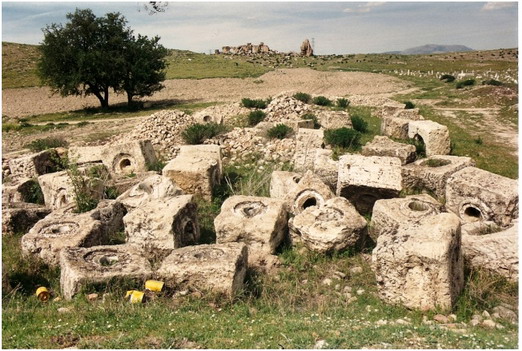
Cordial invitation to the lecture of
Dr. Paul Kessener
Römische Druckleitungen und deren Probleme – Teil 2
(“Roman Siphons and associated Problems – Part 2”)
(Lecture in German)
12.10.2023, 6:00 pm (CET)
Online (ZOOM, Lecture in German)
Photo: Laodikeia - pipe stones from siphon (by Paul Kessener)
Paul Kessener, educated as a fysicist at Nijmegen University , is an independent researcher of Roman aquaducts and water distribution, ancient hydraulics, and hydraulic machines. Special interests are pressure conduits (inverted siphons) and associated problems from air-water interaction , discharge measurements of aqueducts, as well as related literature of ancient authors as Vitruvius, Frontinus, Pliny. Investigations were performed among others at Nîmes, Lyon, Pompeii, Aspendos, Patara, Antiochia ad Cragum, Palermo, Nijmegen. Since 2005 member of the international research team for the investigation of the aqueducts of Ephesos under direction of the Österreiches Archäologisches Institut at Vienna (ÖAI, Dipl.-Ing. Gilbert Wiplinger). Presentations were given at the ‘Cura Aquarum’ conferences and the 'International Congress on the History of Water Management and Hydraulic Engineering’ series. PhD 2017 on Roman Water Distribution and Inverted Siphons (Radboud University Nijmegen, Prof. Dr. Eric Moormann). Publications in international magazines as Babesch, Journal of Roman Archaelogy, and others (https://independent.academia.edu/ PaulKessener). Member of the Frontinus Gesellschaft and of the Deutsche Wasserhistorische Gesellschaft DWhG.
Paul Kessener about the lecture:
In the first part of the lecture on 12.01.2023 it was shown that there were different designs of pressure lines. Normally, pressure pipes consisted of an inlet basin, a downstream pipe, a horizontal pipe in the valley, an upstream pipe and an outlet basin. But there were also penstocks with a hill in between, and then with one or more hydraulic towers on top of a hill, but also with a hill in between without such towers. In the second part of the lecture we will try to find an explanation why these different designs were chosen.
This event is a repeat of the event on 13.04.2023, which had to be cancelled due to technical problems.
The access data for the online meeting (ZOOM) are as follows:
https://us02web.zoom.us/j/87933930044?pwd=dlk4REZ4S0NnL3k2RGN2TVdtZTd3Zz09
Meeting-ID: 879 3393 0044
Kenncode: 631844
The invitation as a document you can download here
Saturday, 03.06.2023 6:00 pm (CET)
Online-Lecture Dr. Jens Köhler - The medieval aqueduct and fountain in Perugia, 08.06.2023
Cordial invitation to the lecture oj
Dr. Jens Köhler
„Der mittelalterliche Aquädukt und Brunnen in Perugia“
(„The medieval aqueduct and fountain in Perugia”)
on 08.06.2023, 6:00 pm (CET)
Online (ZOOM, Lecture in English)
Jens Köhler studied Classical Archaeology, Ancient History, and the Archaeology of the Ancient Near East at Marburg and at Munich universities. He wrote his Ph.D. thesis on festivals and processions of the Hellenistic period. Since the early 1990s, he has lived in Rome, where he worked for several years as a senior researcher for the German Archaeological Institute (DAI), preparing the catalog of ancient sculptures in the Vatican Museums. Köhler is teaching at John Cabot University (JCU) and at The American University of Rome (AUR) courses in Roman archaeology and ancient technology. He is a member of the Frontinus Society since 1998; he helped organizing the ‘big’ Frontinus meeting in Rome 2018. His main research interests are the Roman thermo-mineral baths (or spa baths), a project that was inspired by the Terme Taurine near Civitavecchia, and the ancient aqueducts, for example those for the water supply of Hadrian’s Villa and the Aqua Alexandrina.
Photo: The medieval fountain in Perugia
Jens Köhler about the lecture:
Perugia, the ancient Perusia, now capital of Italy’s Umbria region, owns a fountain famous for its sculptural decoration: the Fontana Maggiore on the main square of the city. Much less well-known than the beautiful fountain is the aqueduct that supplied it with water. The construction is a surprising witness for the legacy and revival of ancient technologies concerning water transport through hilly landscapes, in this case: the inverted siphon. With the approximate date of 1275-1280 it predates the Baroque aqueducts in Rome, the Aqua Felix and the Aqua Paola, more than 300 years. The aqueduct’s sources at Monte Pacciano and its four-kilometer-long path, including several preserved arches, still lack investigation and documentation. This complex building seems not to stand alone in its time: some comparable aqueducts can be found not too far away in Gubbio and in Spoleto. After the transformation into a walkable ramp and only partial restorations during the last decades, lastly rose a major interest in the revalorization of this unique monument.
The access data for the online meeting (ZOOM) are as follows:
https://us02web.zoom.us/j/87933930044?pwd=dlk4REZ4S0NnL3k2RGN2TVdtZTd3Zz09
Meeting-ID: 879 3393 0044
Kenncode: 631844
The invitation as a document you can download here .
Thursday, 11.05.2023 6:00 pm (CAT)
Online-Lecture M. Caschera and M. Placidi - An Aqueduct to Villa Adriana - The Adduction System of the Emperor Hadrian's Villa in Tivoli
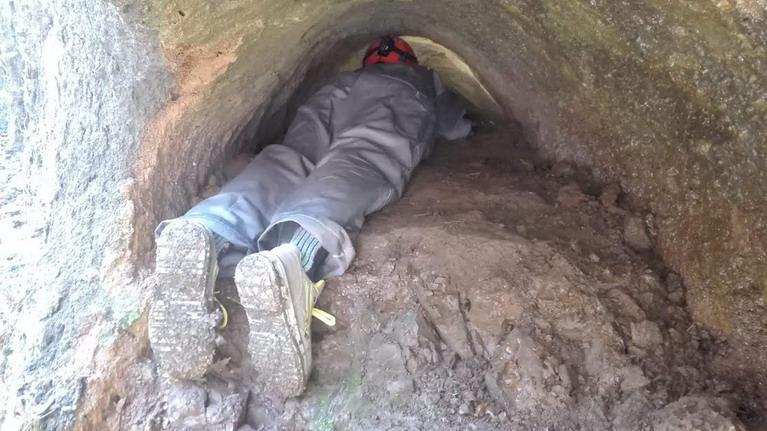
Cordial invitation to the lecture of
Maurizio Caschera and Marco Placidi
„An Aqueduct to Villa Adriana
- The Adduction System of the Emperor Hadrian's Villa in Tivoli (Rome)”
on 11. May 2023, 6:00 pm (CET)
Online (ZOOM, Lecture in English)
Photo: The aqueduct channel discovered near Villa Adriana
Maurizio Caschera began his career as an archaeological speleo researcher within the organization "Sotteranei di Roma". He assiduously participates in the study project of the Emissary of Nemi, in the census of the underground systems of the province of Rome and as research coordinator of the Labyrinth of Rome, a Roman quarry with catacombs inside. He is currently engaged in the study of the imperial aqueducts in the research group dedicated to them.
Marco Placidi, Speleo archaeologist, began his activity as a researcher of the underground systems of Rome and its surroundings, making the activity of this research front a recognized professionalism. He has studied the underground systems of the Roman Forum and Palatine Hill, the Baths of Caracalla, the Cloaca Maxima and the main underground systems of Rome. Also engaged abroad in the study of the aqueducts of Ephesus, he is currently engaged in the documentation of the underground systems of Villa Adriana and of the Emissary of Fucino, one of the largest hydraulic works of the ancient world.
Maurizio Caschera and Marco Placidi about the lecture:
Hadrian’s Villa is an impressive complex built by the Roman Emperor Hadrian on AD 120 as an imperial residence. Stating the importance and the extension of the villa, scope of our study is to understand how the water were delivered to the Villa from all the Roman aqueducts which were passing through the same geographical area. We have defined a possible route considering the result coming from Bibliographic research, territory mapping and evaluations on different Aqueducts’ quota. These presentation shows the methodology followed and the results achieved.
The access data for the online meeting (ZOOM) are as follows:
https://us02web.zoom.us/j/87933930044?pwd=dlk4REZ4S0NnL3k2RGN2TVdtZTd3Zz09
Meeting-ID: 879 3393 0044
Kenncode: 631844
The invitation as a document you can download here
Thursday, 13.04.2023 6:00 (CET)
Online-Lecture Paul Kessener: Römische Druckleitungen und deren Probleme – Part 2

Cordial invitation to the lecture of
Dr. Paul Kessener
Römische Druckleitungen und deren Probleme – Teil 2
(“Roman Siphons and associated Problems – Part 2”)
(Lecture in German)
13.04.2023, 6:00 pm (CET)
Online (ZOOM, Lecture in German)
Photo: Laodikeia - pipe stones from siphon (by Paul Kessener)
Paul Kessener, educated as a fysicist at Nijmegen University , is an independent researcher of Roman aquaducts and water distribution, ancient hydraulics, and hydraulic machines. Special interests are pressure conduits (inverted siphons) and associated problems from air-water interaction , discharge measurements of aqueducts, as well as related literature of ancient authors as Vitruvius, Frontinus, Pliny. Investigations were performed among others at Nîmes, Lyon, Pompeii, Aspendos, Patara, Antiochia ad Cragum, Palermo, Nijmegen. Since 2005 member of the international research team for the investigation of the aqueducts of Ephesos under direction of the Österreiches Archäologisches Institut at Vienna (ÖAI, Dipl.-Ing. Gilbert Wiplinger). Presentations were given at the ‘Cura Aquarum’ conferences and the 'International Congress on the History of Water Management and Hydraulic Engineering’ series. PhD 2017 on Roman Water Distribution and Inverted Siphons (Radboud University Nijmegen, Prof. Dr. Eric Moormann). Publications in international magazines as Babesch, Journal of Roman Archaelogy, and others (https://independent.academia.edu/ PaulKessener). Member of the Frontinus Gesellschaft and of the Deutsche Wasserhistorische Gesellschaft DWhG.
Paul Kessener about the lecture:
In the first part of the lecture on 12.01.2023 it was shown that there were different designs of pressure lines. Normally, pressure pipes consisted of an inlet basin, a downstream pipe, a horizontal pipe in the valley, an upstream pipe and an outlet basin. But there were also penstocks with a hill in between, and then with one or more hydraulic towers on top of a hill, but also with a hill in between without such towers. In the second part of the lecture we will try to find an explanation why these different designs were chosen.
The access data for the online meeting (ZOOM) are as follows:
https://us02web.zoom.us/j/87933930044?pwd=dlk4REZ4S0NnL3k2RGN2TVdtZTd3Zz09
Meeting-ID: 879 3393 0044
Kenncode: 631844
The invitation as a document you can download here
Thursday, 09.03.2023 6:00 pm (CET)
Online-Lecture Nikolaus Arndt: Die Zisterzienser und das Wasser-Kloster Aldersbach
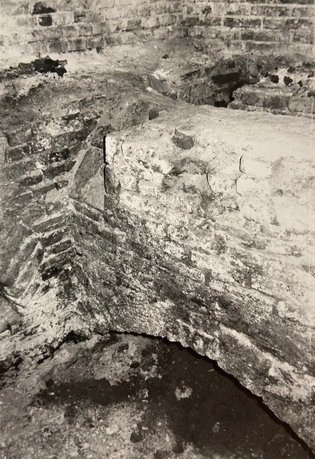
Cordial invitation to the lecture of
Dipl.-Ing. Nikolaus Arndt
„Die Zisterzienser und das Wasser-Kloster Aldersbach“
(“The Cistercians and the Aldersbach Water Monastery”)
09.03.2023, 6:00 pm (CET)
Online (ZOOM, Lecture in German)
Nikolaus Arndt studied civil engineering at the Technical University of Munich. His work in the construction industry has taken him to Germany, Austria and the Czech Republic, as well as to the management of major projects in New Delhi, Kuwait and Libya. The focus was on infrastructure measures such as drinking water and wastewater pipelines, sewage treatment plants, hydraulic engineering and tunnels for sewage and traffic systems. Very impressive was in Tajura (Libya) the connection of the local drinking water network with water from the GMMR project (Great Man Made River), in which fossil freshwater from the Sahara is pumped to the coast. Nikolaus Arndt is an officially appointed expert since 12 years. In addition to researching the historical infrastructure of the Aldersbach monastery, he is also involved in research of hidden subterranean tunnels ( www.erdstallforschung.de ), where there are always interfaces with underground constructions for spring catchments (water tunnels, qanats).
Photo: Latrine facility Aldersbach Monastery
Nikolaus Arndt about the lecture:
The history of Aldersbach Abbey is well researched. In particular, the website www.alderspach.de by PD Dr. Robert Klugseder has been recording historical material since 2021.
Since 2020, Dr Klugseder (Academy of Sciences, Vienna), Wolfgang Vierling (Bauamt Gemeinde Aldersbach) and Nikolaus Arndt have been working on researching the infrastructure of the former Cistercian monastery from its foundation in 1146 onwards. Historical research has not dealt with this topic so far, also because of the complex structural problems.
In this lecture, the supply of process water, mill water and drinking water from the time of the foundation until the secularisation in 1803 and beyond will be presented for the first time. Previously unknown archive pictures showing a monastic latrine system will be shown, as well as a photo documentation of the walled power station canal under the monastery grounds. The Illustration of a 1.7 km long wooden pipeline for transporting drinking water to the monastery according to the hydraulic principle of communicating pipes will arouse the interest of the audience in the medieval hydraulic engineering of the Cistercians.
The access data for the online meeting (ZOOM) are as follows:
https://us02web.zoom.us/j/87933930044?pwd=dlk4REZ4S0NnL3k2RGN2TVdtZTd3Zz09
Meeting-ID: 879 3393 0044
Kenncode: 631844
The invitation as a document you can download here .
Thursday, 12.01.2023 6:00 pm (CET)
Online-Lecture Paul Kessener: Römische Druckleitungen und deren Probleme
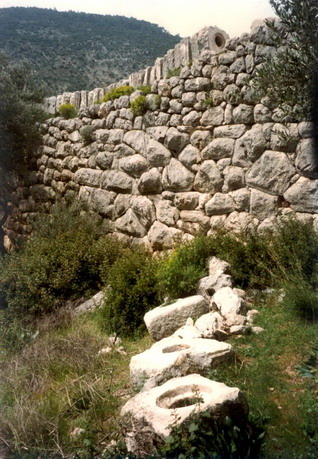
Cordial invitation to the lecture of
Drs. Paul Kessener
“Römische Druckleitungen und deren Probleme”
(“Roman Siphons and associated Problems”)
12.01.2023, 6:00 pm (CET)
Online (ZOOM, Lecture in German)
Paul Kessener, educated as a fysicist at Nijmegen University , is an independent researcher of Roman aquaducts and water distribution, ancient hydraulics, and hydraulic machines. Special interests are pressure conduits (inverted siphons) and associated problems from air-water interaction , discharge measurements of aqueducts, as well as related literature of ancient authors as Vitruvius, Frontinus, Pliny. Investigations were performed among others at Nîmes, Lyon, Pompeii, Aspendos, Patara, Antiochia ad Cragum, Palermo, Nijmegen. Since 2005 member of the international research team for the investigation of the aqueducts of Ephesos under direction of the Österreiches Archäologisches Institut at Vienna (ÖAI, Dipl.-Ing. Gilbert Wiplinger). Presentations were given at the ‘Cura Aquarum’ conferences and the 'International Congress on the History of Water Management and Hydraulic Engineering’ series. PhD 2017 on Roman Water Distribution and Inverted Siphons (Radboud University Nijmegen, Prof. Dr. Eric Moormann). Publications in international magazines as Babesch, Journal of Roman Archaelogy, and others (https://independent.academia.edu/ PaulKessener). Member of the Frontinus Gesellschaft and of the Deutsche Wasserhistorische Gesellschaft DWhG.
Photo: Pressure Line Delikkemer
in Patara/Turkey (Foto Paul Kessener)
Paul Kessener about the lecture:
Today about 1600 Roman and Greek aqueducts are known to have provided water for towns and settlements. To transport water to the desired destinations only one driving force awas applied: gravity. The advantage of gravity is that it is always and everywhere available. But it is also only directed downwards. Liquid water must flow down if it is to get anywhere at all. Thus the constructors of aqueducts had to cope with the terrain between source and destination, by circumventing valleys, building bridges and long arcades, digging tunnels, and in some cases construct pressure lines: siphons. With a siphon water is transported accross a valley by means of a piped conduit that descends to the bottom of the valley and rises up again on the other side to a point a bit lower that the start. Some 80 siphons are known today, at times gaining consideralbe lengths.
In this presentation the problems that could occur with siphons and the solutions that were chosen to cope with these problems are discussed. First a number of siphons will pass the show, after which some considerations on solving problems will be viewed.
The access data for the online meeting (ZOOM) are as follows:
https://us02web.zoom.us/j/87933930044?pwd=dlk4REZ4S0NnL3k2RGN2TVdtZTd3Zz09
Meeting-ID: 879 3393 0044
Kenncode: 631844
The invitation as a document you can download here
Thursday, 08.12.2022 6:00 pm (CET)
Online-Lecture Azriel Yechezkel: Subterranean Tunnels Tapping Groundwater Resources in Israel During the Roman-Byzantine Periods: Local or Imperial Technology?

Cordial invitation to the lecture of
Azriel Yechezkel
Subterranean Tunnels Tapping Groundwater Resources in Israel During
the Roman-Byzantine Periods: Local or Imperial Technology?
08.12.2022, 6:00 pm (CET)
Online (ZOOM, Lecture in English)
Photo: Arched gable, Roman Tunnel of the
Biar Aqueduct to Jerusalem (Yechezkel et al 2021)
Azriel Yechezkel (1984-) has submitted his Ph.D. at the Institute of Archaeology of the Hebrew University of Jerusalem. He is a graduate of the Department of Archeology and the Ancient Near East and the Department of Geography and has a master’s degree with honors from the Department of Geography of the Hebrew University of Jerusalem. His interests include Landscape Archeology, mapping & surveying subterranean structures, geoarchaeology and earth-sciences dating methods. So far, he has published two popular books, and some refereed articles. Recently he led the new survey of the Shaft Tunnel of the Biar Aqueduct to Jerusalem, which revealed unique „water architecture“.
Azriel Yechezkel about the lecture:
Israel is geographically part of the Fertile Crescent, located at the seam between ancient East and West. Due to water scarcity and other environmental strains in its mountainous regions, hydrogeological and engineering innovations were promoted and implemented throughout history to provide water for its ancient inhabitants. One of the most important innovations was the excavation of a sub-horizontal tunnel (spring tunnel: niqba), designed to extract subsurface water to the surface. This technology appeared in Israel since Iron Age (1,000 BC) till the modern period, with a clear peak in the Roman-Byzantine periods.
In the last few years, a thematic survey of this water installation was conducted by the lecturer, documenting more than 210 spring tunnels, from which more than 130 were mapped in detail. This facilitated building of a comprehensive national database of this water technology, including its social and cultural contexts, and chronological aspects. Analysis of this database allows us to discuss the knowledge transfer process and address in the lecture, the following points:
- On what basis was the Roman-Byzantine peak of this technology defined?
- What were the circumstances in which these tunnels were built?
- What Roman 'fingerprints' can be detected in the architecture of Israel's ancient tunnels?
The access data for the online meeting (ZOOM) are as follows:
https://us02web.zoom.us/j/87933930044?pwd=dlk4REZ4S0NnL3k2RGN2TVdtZTd3Zz09
Meeting-ID: 879 3393 0044
Kenncode: 631844
The invitation as a document you can download here .
Photo: Arched gable, Roman Tunnel of the Biar Aqueduct to Jerusalem (Yechezkel et al 2021)
Tuesday, 15.11.2022 16.00–20.00 h (Athens time)
Hybrid Event: New Currents in Ancient Water Studies III
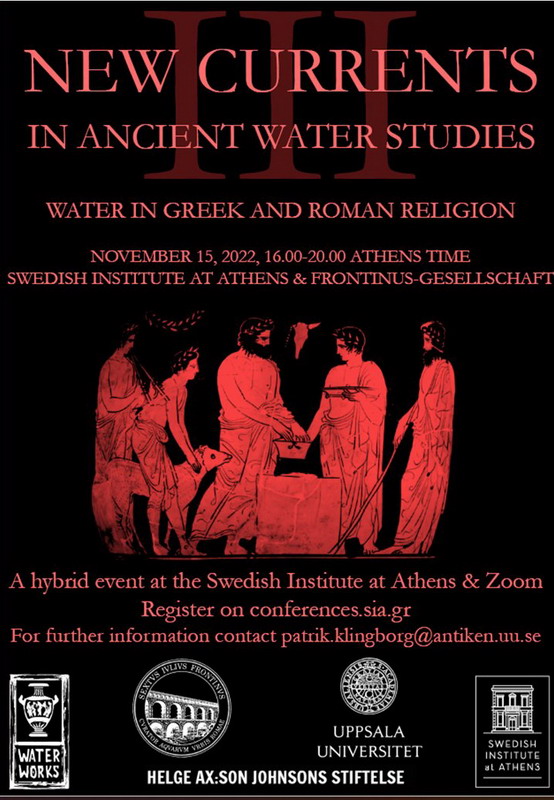
You are hereby invited to the workshop
New Currents in Ancient Water Studies III
– Water in Greek and Roman Religion -
arranged by Patrik Klingborg at Uppsala University as a cooperation between the Swedish Institute at Athens and the Frontinus Gesellschaft, November 15, 2022, 16.00–20.00 (Athens time). The aim of the workshop is to explore various facets of water usage within Greek and Roman cults. What role did water play in religious life, who used it, when and for what purpose? In order to approach this, six papers focusing on different aspects are presented, ranging from water cults in Thrace and Macedonia and how water usage affected, and was in turn affected by, the physical layout of ritual sites, to the use of water in libations and Roman mortuary practices.
16.00: Patrik Klingborg – Introduction
16.15: Georgia Aristodemou – Water cults in roman Macedonia. The importance of Rivers as gods in the regions of Macedonia and Thrace during the Roman period, as examined through their myths and material evidence
16.45: Jens Krasilnikoff – Water in ancient Greek food systems. Towards a new analytic perspective with examples from Athens, Metapontum and Gortyn 5th – 3rd century BC.
17.15: Axel Frejman, Patrik Klingborg & Hedvig von Ehrenheim – Spatiality of water at Greek sanctuaries
17.45: Coffee
18.00: Dan Anca – River cults between the Greek, Anatolian and Iranian worlds
18.30: Sebastian Zerhoch – A protean liquid: water in ancient Greek libation practice
19.00: Richard Ascough – Water rituals and Roman mortuary practices
19.30: Open discussion
The workshop takes place as a hybrid event, physically at the Swedish Institute at Athens and digitally on Zoom. Please register at conferences.sia.gr for participation. For further information, contact patrik.klingborg@antiken.uu.se .
The Poster of this Workshop you can download here , the program here .
Thursday, 10.11.2022 6:00 pm (CET)
Online Lecture Jim Crow: Water for High Places: Recent Research on the Water Supply of Constantinople, 10.11.2022
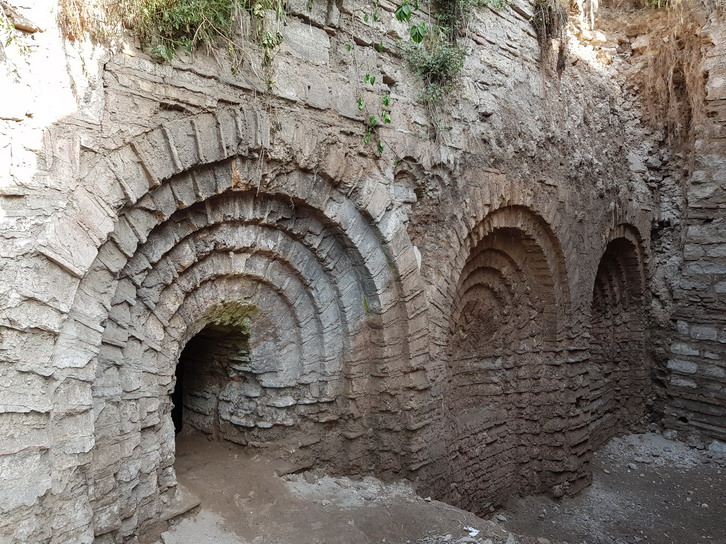
Cordial invitation to the lecture of
Prof. Jim Crow
Water for High Places: Recent Research on the Water Supply of Constantinople with Reference to the First Hill - the Acropolis of Byzantium
10.11.2022, 6:00 pm (CET)
Online (ZOOM, Lecture in English)
Photo: Middle Byzantine fountain house near
the Pantokrator Monastery, (© Kerim Altug)
Jim Crow teaches Roman and Byzantine archaeology at the University of Edinburgh. He directed excavations for the National Trust on Hadrian’s Wall from 1982-1989, and subsequently taught at Warwick and Newcastle Universities before his current post as Professor of Classical Archaeology at Edinburgh. In Turkey he has directed survey projects on the Black Sea and from 1994 in the west hinterland of Istanbul, surveying and documenting the Anastasian Wall and the Water Supply of Byzantine Constantinople. In 2012 he organised an exhibition with colleagues from Istanbul Technical University on the water supply at ANAMED (Research Centre for Anatolian Civilizations) in Istanbul. Currently he is the co-investigator of a British Academy/British Institute at Ankara project on Water in Istanbul, Rising to the Challenge, contrasting water management between the Byzantine/early Ottoman and contemporary city. He is the current chair of the British Institute at Ankara. His publications include two books on Hadrian’s Wall, a monograph on the water supply of Constantinople, an edited volume on Byzantine Naxos and the Aegean and numerous articles on frontiers, fortifications, hydraulic infrastructure of Constantinople and landscape archaeology in the eastern Mediterranean and the Black Sea.
Jim Crow about the lecture:
The new city of Constantinople benefitted from one of the greatest and most extensive hydraulic systems in the ancient world. A water supply system which continued well into the high middle ages. My talk will initially briefly outline the key elements of the hydraulic infrastructure, both outside and within the late antique and medieval city. Then I will focus on the recent project which examines the supply, distribution and storage on the city’s first hill, the acropolis of Byzantium, and the site of Mehmet II’s palace, the Topkapi Saray. This was one of the highest places across the city and raised particular challenges for water provision. One feature of the Byzantine system was innovation and the construction of new water systems and changes patterns of distribution. Little is known from written sources but study of the physical remains from an archaeological and engineering perspective allows new insights into the maintenance and evolution of the ancient Roman system.
The access data for the online meeting (ZOOM) are as follows:
https://us02web.zoom.us/j/87933930044?pwd=dlk4REZ4S0NnL3k2RGN2TVdtZTd3Zz09
Meeting-ID: 879 3393 0044
Kenncode: 631844
The invitation as a document you can download here .
Thursday, 13.10.2022 6:00 pm (CET)
Online-Lecture Dr. Gemma Jansen: Fountains in Roman Garden Paintings (Case Study Pompeii), 13.10.2022
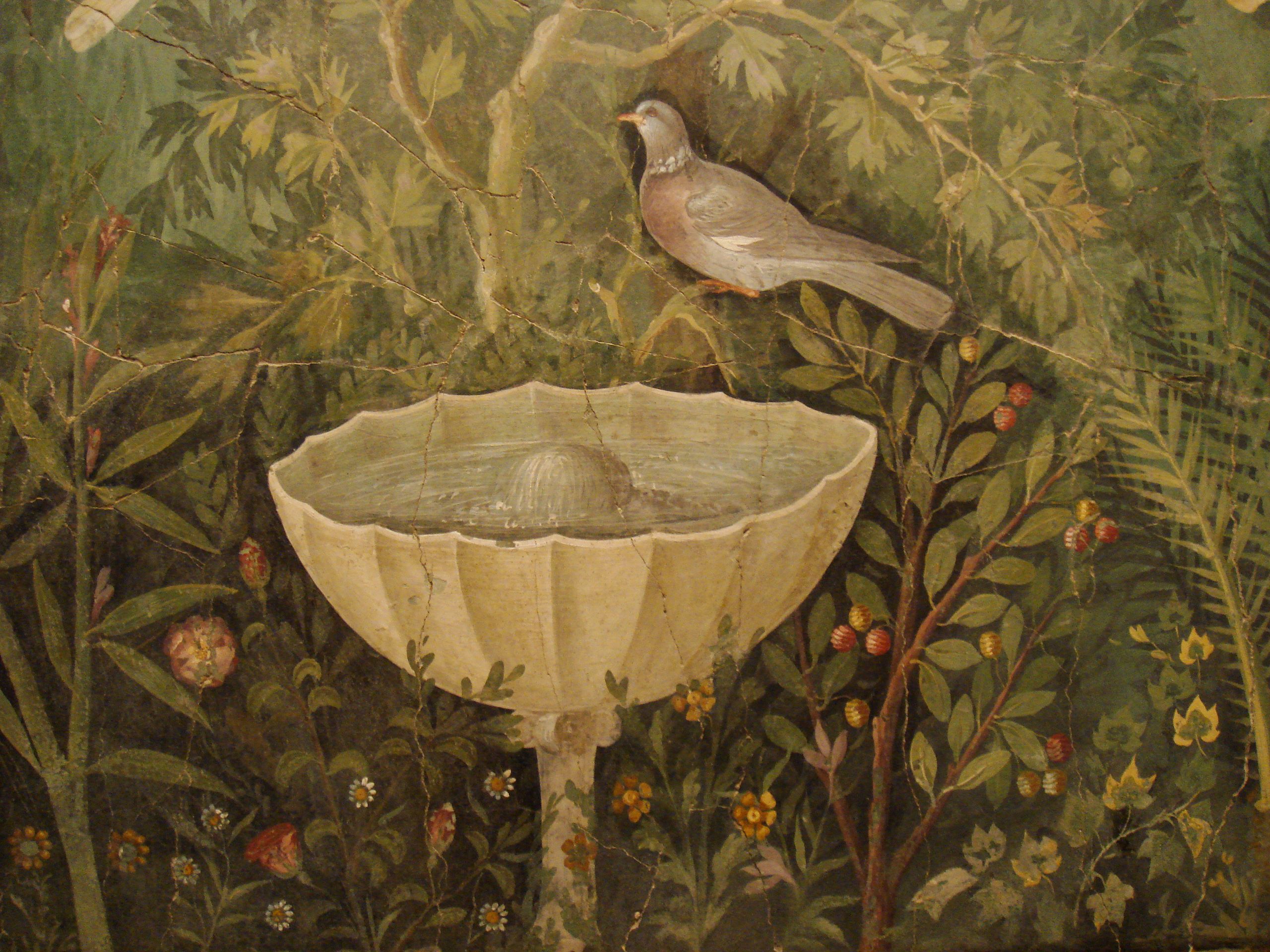
Cordial invitation to the Lecture of
Dr. Gemma Jansen
Fountains in Roman Garden Paintings (Case Study Pompeii)
13.10.2022, 6:00 pm (CET)
Online (ZOOM, Lecture in English)
Illustration: Garden painting with fountain from Pompeii
(House of the golden bracelet, VI ins occidentalis, 42)
from Wiki commons
Gemma Jansen is archaeologist and wrote her dissertation at Nijmegen University (the Netherlands) on water systems inside the three Roman towns of Pompeii, Herculaneum and Ostia. She has investigated Roman toilets and urinals at length, also at other Roman sites. Recently, she is investigating the relation between humans and Roman technology and she tries to find out - among other things – who the people were that built the aqueducts and what Romans actually thought about their sewer systems. At the moment she is writing a book on Roman gardens.
About the lecture:
The gardens of the Roman town of Pompeii show hundreds of fountains and fountain statues. Their diversity is enormous; they vary from simple waterfalls over steps up to large groups of statuettes spouting water in the air. It is apparent that the fountains painted on the fresco walls of Pompeii are rather different from the ones that occur in the real gardens. They are limited to a rather restricted assortment and – somewhat unexpected – they show other fountain types than the ones excavated in the nearby gardens. A closer look reveals that the painted fountains are no snapshot of real fountains. However, what are they? We are going to explore Roman fantasies in which water plays an important role.
The access data for the online meeting (ZOOM) are as follows:
https://us02web.zoom.us/j/87933930044?pwd=dlk4REZ4S0NnL3k2RGN2TVdtZTd3Zz09
Meeting-ID: 879 3393 0044
Kenncode: 631844
The invitation as a document you can download here .
Thursday, 08.09.2022 until September 15, 2022
International Conference of the Frontinus Society Bathing Culture in Budapest
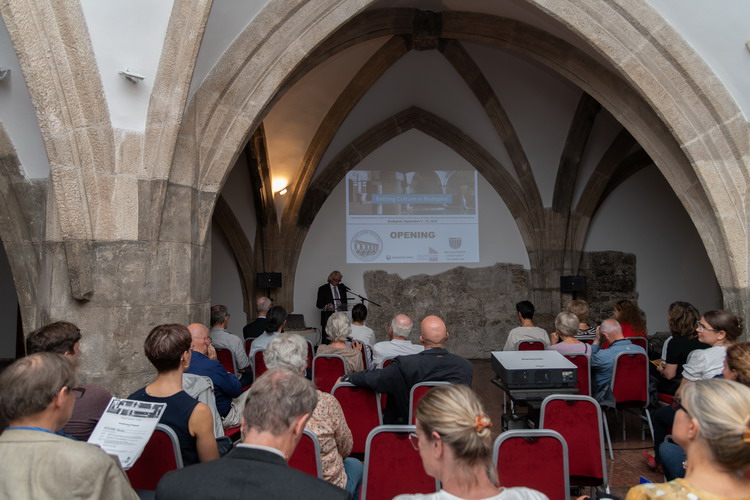
The Frontinus Society's international symposium on bathing culture in Budapest, held from September 8 to 15, 2022, was a continuation of the Frontinus Society's symposia in Aachen, Vienna, Antalya, Trier, and Rome, and was again a great success.
47 participants from 13 different nations experienced the program of lectures and excursions put together by Gilbert Wiplinger with the help of Adrienn Papp (Budapest History Museum) and Gabriella Fényes (Aquincum Museum). In 19 lectures, baths in Budapest were presented from antiquity to the Ottoman baths to the current use of all facilities up to the 21st century. During the excursions, new knowledge could be gained on site and practical experience could be gained immediately during a visit to two baths.
A detailed report on this symposium can be found here .
Figure: The Gothic Hall of the Budapest History Museum as a lecture hall during the opening of the symposium (© Ákos Keppel /BTM).
Thursday, 09.06.2022 6:00 pm (CET)
Online Lecture Elettra Santucci: Rome Transformed Project - The Supply and Use of Water in the Eastern Caelian
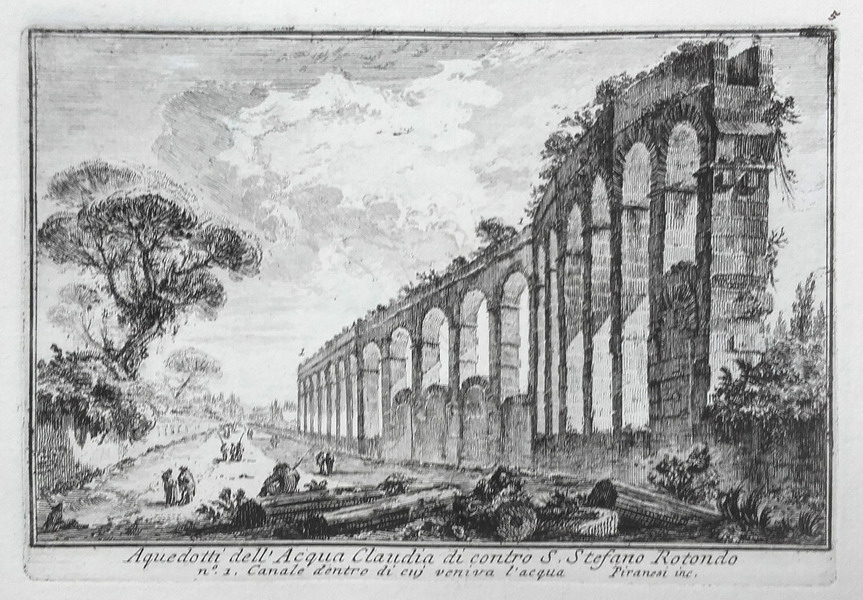
Cordial invitation to the online lecture of
Elettra Santucci
Rome Transformed Project: The Supply and Use of Water in the Eastern Caelian
09.06.2022, 6:00 pm (CET)
Online (ZOOM, Lecture in English)
Photo: Giovanni Battista Piranesi, view of the
Aqua Claudia on the Caelian Hill, Rome (1748)
Elettra Santucci is Architect (Roma Tre University) and archaeo-speleologist (Roma Sotterranea). She collaborates as a freelance architect in projects related to Cultural Heritage and archaeological sites. Her fields of research are Roman architecture, Roman hydraulic systems and techniques, Roman aqueducts, underground sites, surveys and 3D modelling. Now she is leading a PhD research in the ‘Rome Transformed Project’ at Newcastle University. Research projects on Roman monuments held: Cloaca Maxima, Diocletian Baths, Trajan Baths, Villa of Maxentius, Domitian Terrace nymphaeums, Capitoline Hill’s slope buildings, Roman aqueducts (Aqua Appia, Anio Vetus, Aqua Claudia, Aqua Traiana), Ostia Antica.
About the lecture:
The Rome Transformed Project ( https://research.ncl.ac.uk/rometrans/ ) is an ERC-funded project which undertakes interdisciplinary analysis on the urban transformations of the eastern Caelian in Rome, looking at how different aspects - political, military, and religious - influenced the changing of the city landscape from the 1st to the 8th centuries AD. The analysis of the hydraulic systems is a specific part of the project and will help to understand how this area of the city was supplied, how the distribution system worked and how much water was directed to specific areas and buildings. The changing occurred in the hydraulic structures will reflect the transformation of the quartier through time.
The access data for the online meeting (ZOOM) are as follows:
https://us02web.zoom.us/j/87933930044?pwd=dlk4REZ4S0NnL3k2RGN2TVdtZTd3Zz09
Meeting-ID: 879 3393 0044
Kenncode: 631844
The invitation as a document you can download here .
Thursday, 12.05.2022 6.00 pm (CET)
Online Lecture Dr. Patrik Klingborg: Social stratification and water at Hellenistic Delos
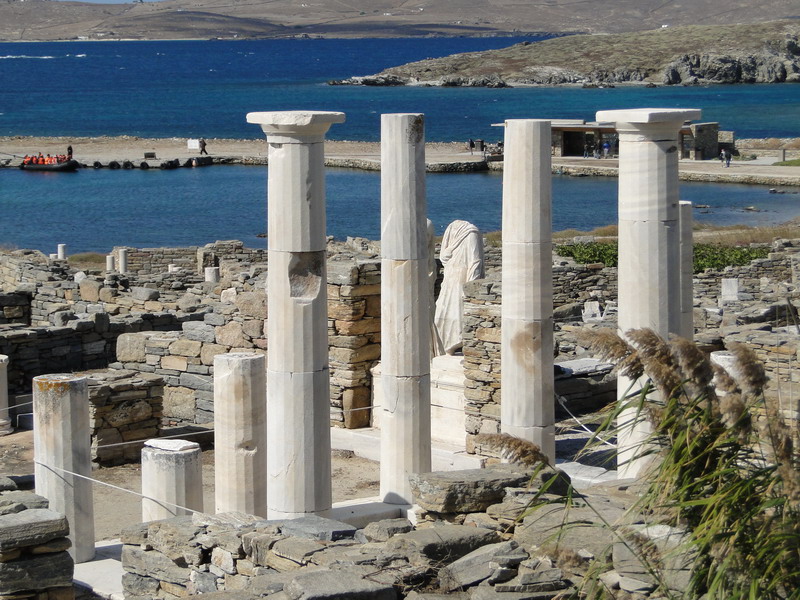
Cordial invitation to the Lecture of
Dr. Patrik Klingborg
"Social stratification and water at Hellenistic Delos"
12.05.2022, 6:00 pm (CET)
Online (ZOOM, Lecture in English)
Dr. Patric Klingborg is a member of the Board of Directors and of the Scientific Advisory Board of the Frontinus Society. He is a researcher and assistant professor at the department of Archaeology and Ancient History at Uppsala University, studying ancient Greek cisterns and the use of water in Greek sanctuaries. Previously he worked as the assistant director at the Swedish Institute at Athens, where he recently published the results of the exploration of the water supply at ancient Hermione.
About the lecture:
Delos has long been known as a dry, devoid of water source with the exception of cisterns. While this notion is still prevalent today, the inhabitants of Delos had access to an extensive network of water sources, including wells, cisterns and a hybrid of these, sometimes called infiltration wells. However, these water sources were unevenly distributed and access restricted in many cases, leading to a highly stratified society in terms of water availability. This paper explores the distribution of the water sources, who would have access to these and how this affected the social fabric of Delos. This is done primarily through a GIS analysis of the material in the well preserved insulae II–IV and VI in the Quartier du Théâtre using on an open access base map provided by the École française d'Athènes. Through this it is shown that despite the presence of a large number of water source, access to this was a premium that probably had to be negotiated between the inhabitants in the various domestic units, creating life important dependencies between individuals.
The access data for the online meeting (ZOOM) are as follows:
https://us02web.zoom.us/j/87933930044?pwd=dlk4REZ4S0NnL3k2RGN2TVdtZTd3Zz09
Meeting-ID: 879 3393 0044
Kenncode: 631844
The invitation as a document you can download here
Thursday, 07.04.2022 6:00 pm (CET)
Online Lecture Dr. Amanda Kelly: The Venetian Aqueduct of Iraklio - from Roman Beginnings to 19th Century Reuse
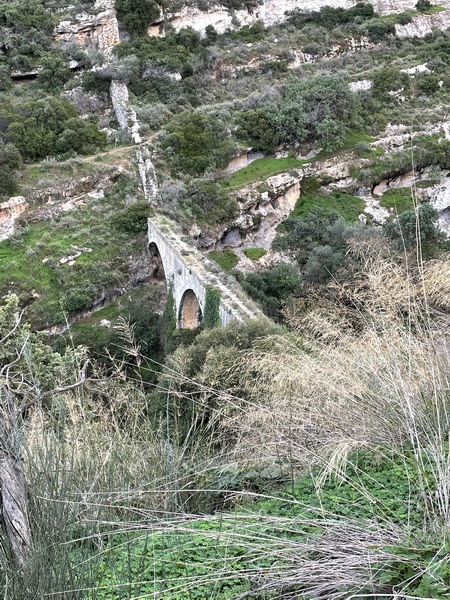
Cordial invitation to the Lecture of
Dr. Amanda Kelly
„The Venetian Aqueduct of Iraklio; from Roman Beginnings to 19th Century Reuse“
on 07. April 2022, 6:00 pm (CET)
Online (ZOOM, Lecture in English)
Dr. Amanda Kelly is Assistant Professor in the School of Archaeology at University College Dublin. She is an archaeologist specialising in Roman aqueducts and baths (with a focus on Crete). She completed her PhD on this topic in the School of Classics at Trinity College Dublin in 2005. Dr Kelly leads the project "Aqueducts in the Greater Iraklio Area (AGIA)" which is generously funded by the Gerda Henkel Foundation (2021-2023)
About the lecture:
In November 2019, I walked the Roman aqueduct supplying Knossos. The fieldwork was the start of my on-going project “Aqueducts of the Greater Iraklio Area (AGIA)” generously funded by The Gerda Henkel Foundation. One of my key findings from 2019 was the architectural identification of the Roman channel underlying the 19th-century wall of the Ottoman-Egyptian aqueduct supplying Iraklio. Consequently, the 2019 survey not only mapped the full length of the Roman aqueduct supplying the city of Knossos but also that section of the 19th-century Ottoman-Egyptian aqueduct of Iraklio built directly over it and a shorter tract of the Venetian aqueduct of Iraklio that either ran alongside it, or was, in turn, itself, partially overlaid by the 19th-century system. The Venetian aqueduct had not been surveyed since Giuseppe Gerola’s fieldwork in the 1900s and was the subject of our field study in 2021. This fieldwork was meant to be straightforward as I had found the aqueduct route marked on the military maps of Crete and was familiar with the terrain. Not so, and perhaps the biggest surprise of the 2021 fieldwork was the discovery of an in situ Roman-type stone pipeline at Karydaki (the main spring source of the Venetian aqueduct). In my presentation I will guide you along the route of the Venetian aqueduct of Iraklio and highlight the many challenges I faced in the field.
The access data for the online meeting (ZOOM) are as follows:
https://us02web.zoom.us/j/87933930044?pwd=dlk4REZ4S0NnL3k2RGN2TVdtZTd3Zz09
Meeting-ID: 879 3393 0044
Kenncode: 631844
The invitation as a document you can download here .
Thursday, 13.01.2022 6.00 pm (CET)
Online-Lecture Dr. Heidi Köpp-Junk: Innovations in Drainage Technology in Pharaonic Egypt
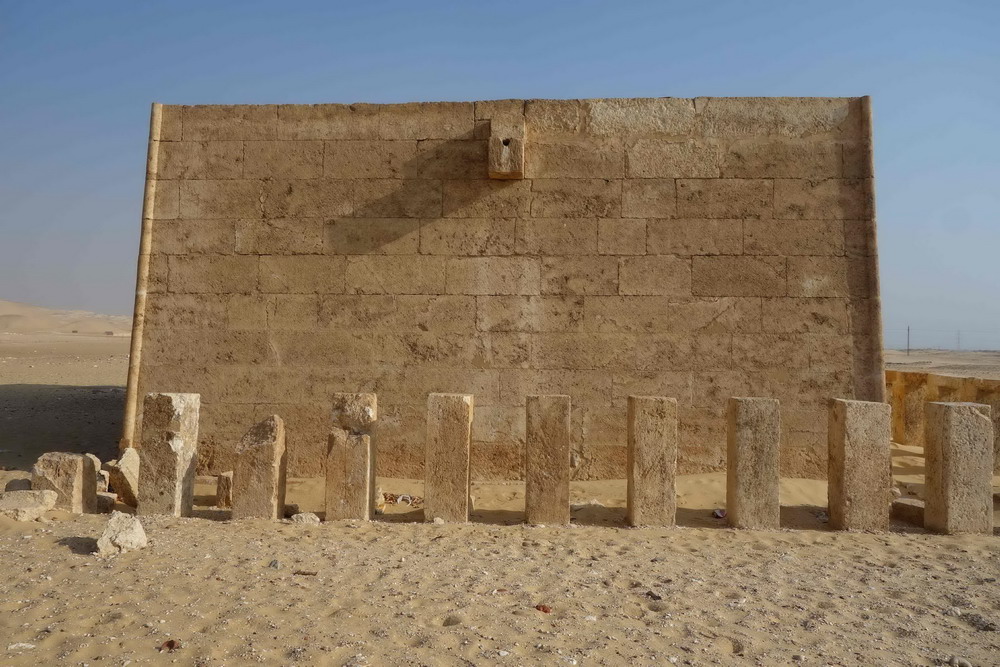
Cordial invitation to the Lecture of
Dr. Heidi Köpp-Junk
"Innovations in Drainage Technology in Pharaonic Egypt"
(Lecture in German)
on 11.11.2021, 18.00 6:00 pm CET
Online (ZOOM).
Dr. Heidi Köpp-Junk is Assistant Professor in Egyptian Archaeology at the Institute of Mediterranean and Oriental Cultures, section for Egyptian temples, Polish Academy of Sciences Warsaw. She studied Egyptology, Prehistory and Ethnology at the University of Göttingen and wrote her Ph.D. about “Travel in Pharaonic Egypt”. Since that she worked at several Universities and German and European museums. Since many years she has been excavating in Germany and Egypt (Dahshur, Elephantine, Buto, Abydos, Sakkara, Qantir, Athribis, Tuna el-Gebel) for several institutions like the German Archaeological Institute (DAI). She has been studying ancient Egyptian drainage systems since 2002 and has since written various articles on the subject. A book on that topic is currently in progress.
About the lecture:
While irrigation is very often discussed in Egyptology, dewatering systems are not. Therefore the lecture focuses on dewatering systems for rain water and used water in Pharaonic Egypt. This practice has so far been attributed to the Romans, but the oldest installation in Egypt dates to 3100 BC. Already in the time of the pyramids, techniques were attested that are still in use today, showing that ancient Egyptian builder and engineers were very inventive and creative. The drainage of used water is documented for example in the palaces of Medinet Habu and in Amarna, the city of Akhenaten and Nefertiti. Moreover, the lecture presents Heidi Köpp-Junks latest excavation results from the temple of Athribis and the necropolis of Tuna el-Gebel.
The access data for the online meeting (ZOOM) are as follows:
https://us02web.zoom.us/j/87933930044?pwd=dlk4REZ4S0NnL3k2RGN2TVdtZTd3Zz09
Meeting-ID: 879 3393 0044
Kenncode: 631844
The invitation as a document you can download here .
Thursday, 09.12.2021 6.00 pm (CET)
Online-Lecture Florian Tanz: Das Badewesen im römischen Trier und dessen Umland
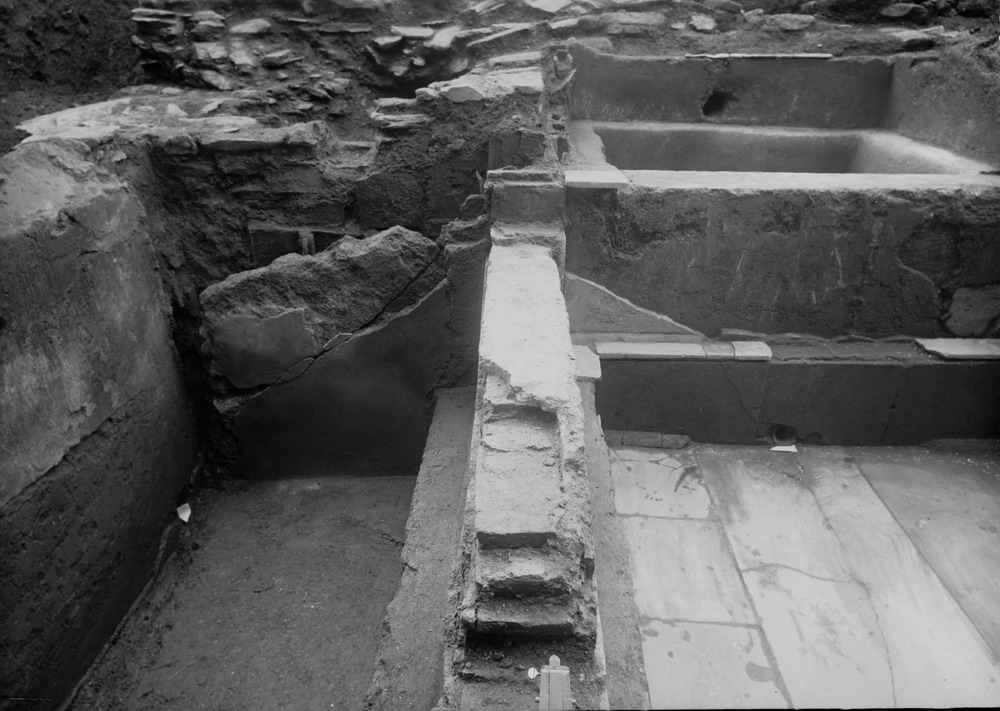
Cordial invitation to the Lecture of
Florian Tanz
"Das Badewesen im römischen Trier und dessen Umland"
(Lecture in German)
on 09.12.2021, 6:00 pm CET
Online (ZOOM)
Florian Tanz studied Classical Archaeology and Egyptology at the University of Trier. He did his doctorate on the water supply and sewage disposal of Roman Trier. Since October, he has been employed by the city of Trier in a model project for the creation of an archaeological urban cadastre.
About the lecture:
Bathing is an integral part of Roman culture. It is therefore not surprising that numerous traces of ancient baths have also been preserved in the territory of the Treverians. In addition to the three large thermal baths in Trier, a good dozen other bathing facilities are known from the city. But baths were also part of the equipment in the villas in the countryside. The lecture will give an overview of the development in the city and the countryside. In addition to the well-known large spas, small baths and their equipment will also be presented.
The access data for the online meeting (ZOOM) are as follows:
https://us02web.zoom.us/j/87933930044?pwd=dlk4REZ4S0NnL3k2RGN2TVdtZTd3Zz09
Meeting-ID: 879 3393 0044
Kenncode: 631844
The invitation as a document you can download here .
Tuesday, 16.11.2021 4.00 h pm (GMT+2)
Online-Workshop: New Currents in Water Studies
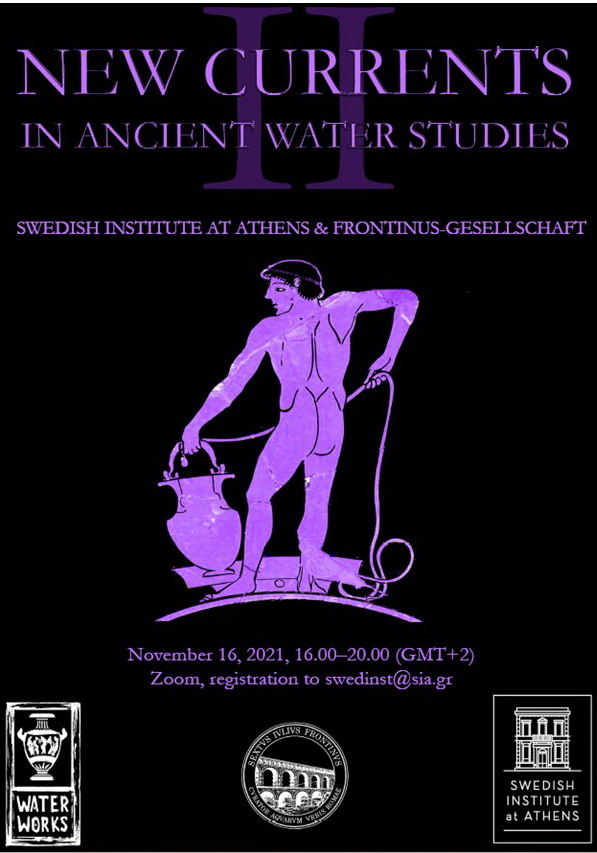
On 16.11.2021 the Swedish Institute in Athens and the Frontinus Society are organising an online workshop "New Currents in Waster Studies". The following contributions are planned (all times in Greek time - GMT+2):
16.00: Patrik Klingborg – Introduction
16.15: Amanda Kelly – Recent work on the aqueducts of the greater Iraklio area
16.45: Sophia Germanidou – Hydromedie programme: Water collection, storage and management in Messinia, southern Greece. Traditional methods and innovative methodologies
17.15: Hedvig von Ehrenheim, Patrik Klingborg & Axel Frejman – Ritual usage of water in Greek Sanctuaries
17.45: Coffee
18.00: Emelie Byström – Bodies in water: Nymphs and water on Sicily
18.30: Heidi Köpp-Junk – Neueste Untersuchungen zu den Wasserspeiern in der Nekropole von Tuna el Gebel/Ägypten - Dachentwässerungstechniken an Gräbern, Tempeln und Tempelgräbern
19.00: Betsey Robinson – What Lies Beneath: The Peirene Valley before the Peribolos of Apollo (Corinth Greece)
19.30: final discussion
Please contact swedinst@sia.gr if you wish to register
Thursday, 11.11.2021 6.00 h PM (CET)
Lecture Maria Grazia Cinti: New Light on the Aqua Alsietina and the Naumachia Augusti: Recent Studies and Future Perspectives
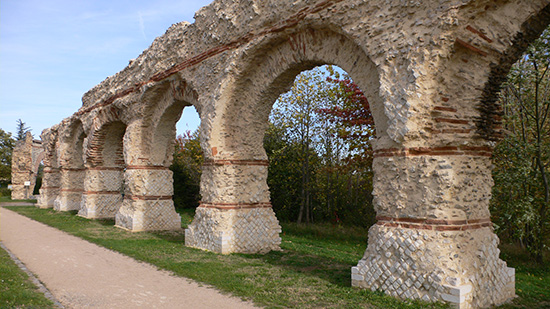
Cordial invitation to the Lecture of
Maria Grazia Cinti, MA und PhD
New Light on the Aqua Alsietina and the Naumachia Augusti
- Recent Studies and Future Perspectives -
(Lecture in English)
on 11.11.2021, 6:00 pm CET
Online (ZOOM)
Maria Grazia Cinti completed her Master's degree in classical archaeology (ancient topography and latin epigraphy) with a thesis about the building program of Septimius Severus and about the epigraphic evidences for known and unknown monuments; She received her PhD in Archaeology with a project about the Aqua Alsietina. She is currently working as an independent researcher on the aqueduct. Additionally she collaborates with Italian television in a programme about history for the last 4 years.
Abstract:
We have two main sources for the knowledge of this structure: Frontinus for the ancient era and Nibby for modern studies. Despite there are lots of things that we still don’t know about the aqueduct and the other structures connected to it – first of all the Naumachia -, this lecture presents some of the results I achieved during my PhD. Thanks to the surveys and to the research in archives and libraries, in fact, today it is possible to track almost the whole course of the Alsietina. I will be particularly focused on an area near Osteria Nuova in which there are clear evidences of the aqueduct with many archaeological remains.
The access data for the online meeting (ZOOM) are as follows:
https://us02web.zoom.us/j/87933930044?pwd=dlk4REZ4S0NnL3k2RGN2TVdtZTd3Zz09
Meeting-ID: 879 3393 0044
Kenncode: 631844
The invitation as a document you can download here .
Wednesday, 22.09.2021 6:00 pm (CET)
Lecture Mark Locicero - The Waters and Drains of Volubilis: A Preliminary Assessment - 14.10.2021

Cordial invitation to the
Lecture of Dr. Mark Locicero
The Waters and Drains of Volubilis
- A Preliminary Assessment -
(Lecture in English)
on 14.10.2021, 18.00 6:00 pm (CET)
Online (ZOOM)
Mark Locicero is presently an Affiliate Research Fellow at the University of British Columbia. His research into the role of water in the ancient Mediterranean world aims to incorporate leading methods and theories of sustainable resource management. Mark Locicero has taught extensively on themes of resources, environment, and technologies in the ancient Mediterranean world. His research seeks to put urban patterns of water supply, usage, and drainage in their larger historical contexts. He is a member of the Scientific Board of the Frontinus Society.
Abstract:
This lecture presents the preliminary results of a re-examination of the complete hydraulic history of the Roman city of Volubilis. Located in northern Morocco, Volubilis lies along the Roman frontier, and was an important provincial center. The city has received fragmentary treatment from past archaeological research, most of which focused on architectural and decorative aspects of several wealthy peristyle homes. However, recent research has begun to place the sewers and lead pipes associated with these homes in a longer chronological perspective. This talk moves beyond the colourful mosaics to examine how the city dynamically interacted with local resources to grow into a prosperous and influential city.
Please register by 01.10.2021 with the keyword "Invitation Lecture Locicero" at the office of the Frontinus Society:
Tel: +49-228/9188-666, Fax: +49-228/9188-92-666, E-Mail:
info@frontinus.de
The access data for the online meeting (ZOOM) are as follows:
https://us02web.zoom.us/j/81900110371?pwd=SFlrY3R6bDQ2OEc0V3Z3Vk9vMkFvdz09
Meeting-ID: 819 0011 0371
Identification code: 537484
The invitation as a document you can download here .
Thursday, 09.09.2021 6:00 pm
Lecture Ingrid Hehmeyer Indigenes Wissen oder Techniktransfer? - Die unterirdischen Kanalsysteme im Jemen 09.09.21
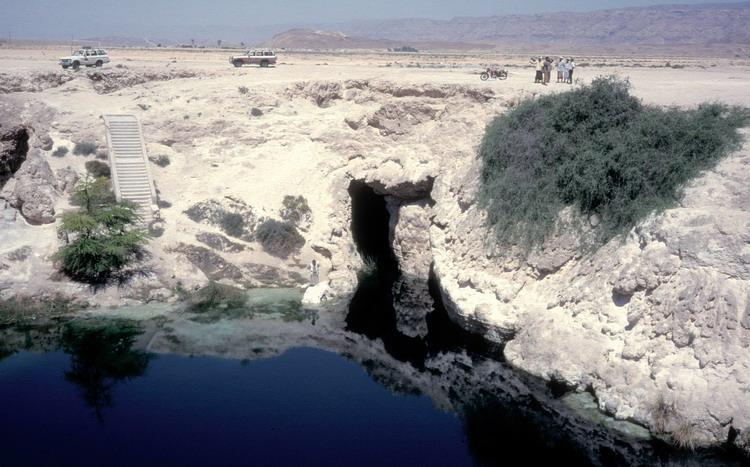
Cordial Invitation
to the Online Lecture on 09.09.2021, 6:00 pm
Prof. Dr. Ingrid Hehmeyer
Indigenes Wissen oder Techniktransfer? - Die unterirdischen Kanalsysteme im Jemen -
Ingrid Hehmeyer is Professor of History of Science and Technology at Ryerson University in Toronto/Canada. After studying agricultural sciences, she wrote her dissertation on irrigated agriculture at the ancient oasis in Marib, Yemen, at the University of Bonn and has since spent many years researching the history of hydraulic engineering and water management in Yemen.
Abstract:
The underground canal systems of the city of Ghayl Ba Wazir in southern Yemen represent an impressive testimony to the efficient use of the scarce natural resource of water. In my presentation, I will explain the technical principles of water use that reflect the ability of the people to adapt to local environmental conditions. In water distribution, the supply of clean water to the urban population was a priority. Only after the tunnels had crossed the city was the gray water piped to the gardens outside the city for irrigation.
Please register by 01.09.2021 with the keyword "Invitation Lecture Hehmeyer" at the office of the Frontinus Society:
Tel: +49-228/9188-666, Fax: +49-228/9188-92-666, E-Mail:
info@frontinus.de
The access data for the online meeting (ZOOM) will be sent to you after receipt of the registration.
You can download the invitation as a document here .
Friday, 15.01.2021 until January 16 2021
Online-Workshop „Roman Baths and Thermo-Mineral Baths in Urban and (Micro-)Regional Perspectives“, Kiel University, 15 - 16 January 2021
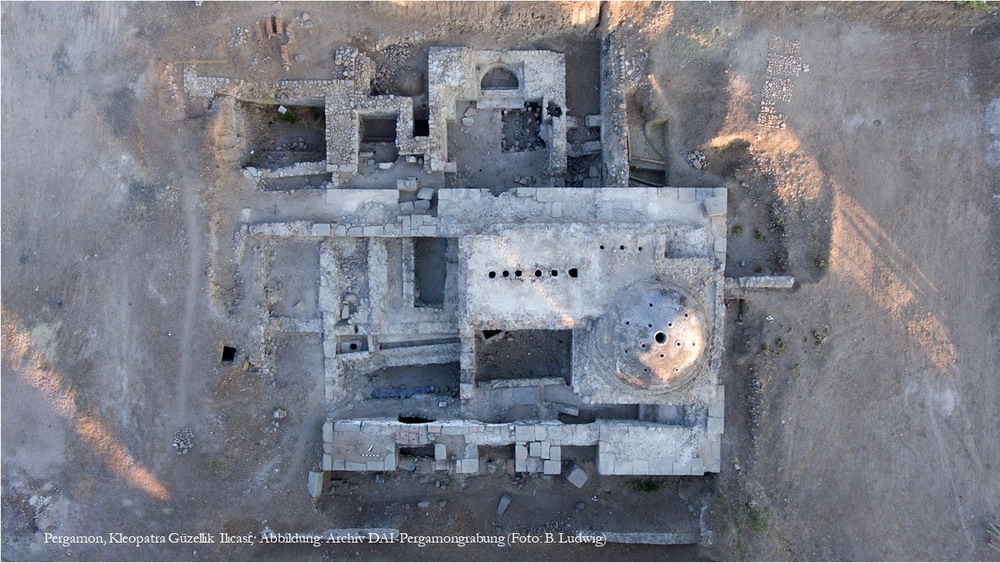
Over recent years, the archaeological disciplines have renewed their interest in Roman bathing culture and Roman baths in their various forms. The workshop aims to discuss current research approaches in the field of Roman baths and thermo-mineral baths while creating a networking platform for young researchers working on Roman baths, thermo-mineral baths and bathing culture.
This workshop is aimed at early-career researchers (MA/Doc/Post-Doc) in particular. We welcome contributions on current research projects and theses/dissertations from archaeology and its related disciplines. The conference languages are German and English. The event will be held online via ZOOM.
Further information on the workshop topics and the Call for Papers can be found here .
Picture: Pergamon, Kleopatra Güzellik Ilicasi; Figure: Archive Pergamon Excavation (Photo: B. Ludwig)
Tuesday, 10.11.2020 16.00–20.00 h (GMT+2)
ZOOM-Workshop "New Currents in Ancient Water Studies", 10.11.2020
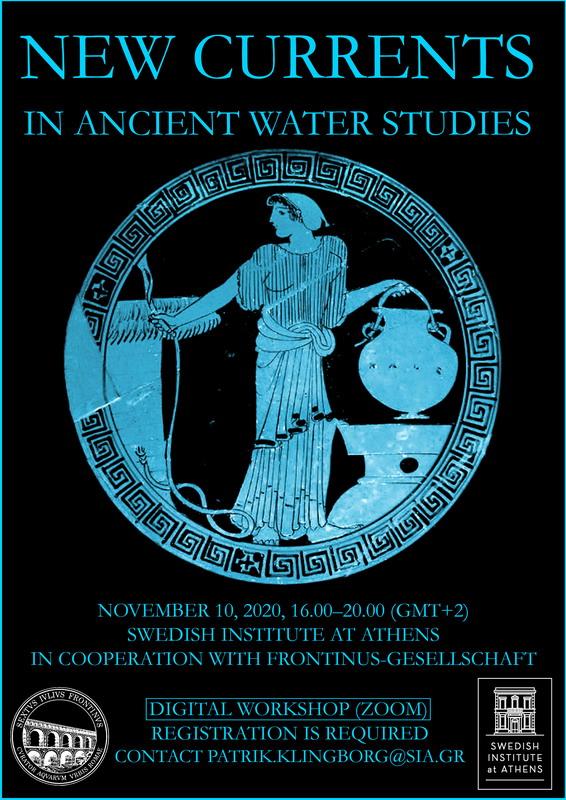
The digital workshop New Currents in Ancient Water Studies is arranged in cooperation between the Swedish Institute at Athens and the Frontinus Gesellschaft. The event aims to present ongoing projects studying the water supply in the ancient world from the Levant and North Africa to the northern provinces of the Empire and Rome itself. The workshop begins from the east with Rick Bonnie, Saimi Kautonen and Niko Aarnio discussing the religious responses to climate change through the usage of Jewish ritual baths during the Roman period. Thereafter, new work tracing the water system in Trier is presented by Florian Tanz and Sascha Schmitz, as well as the results of recent fieldwork in Hermione in the Argolid by Patrik Klingborg. The workshop then continues with Dylan Rogers who presents his newly published research on water and memory on the Forum Romanum in Rome. This leads up to Cecelia Feldman’s talk on the interrelationship between Greek mythology and hydrology. Finally, the workshop is concluded by Mark Locicero who discusses the, often hidden, water systems in Roman Volubilis, located in modern Marocco. By doing so he sheds light on an otherwise often overlooked part of the Empire.
Note that the event will take place digitally using Zoom, November 10, 2020, 16.00–20.00 (GMT+2). Registration to patrik.klingborg@sia.gr is required in order to participate.
You can find the program here .
Saturday, 11.07.2020 3 pm
General Meeting of the Frontinus Society
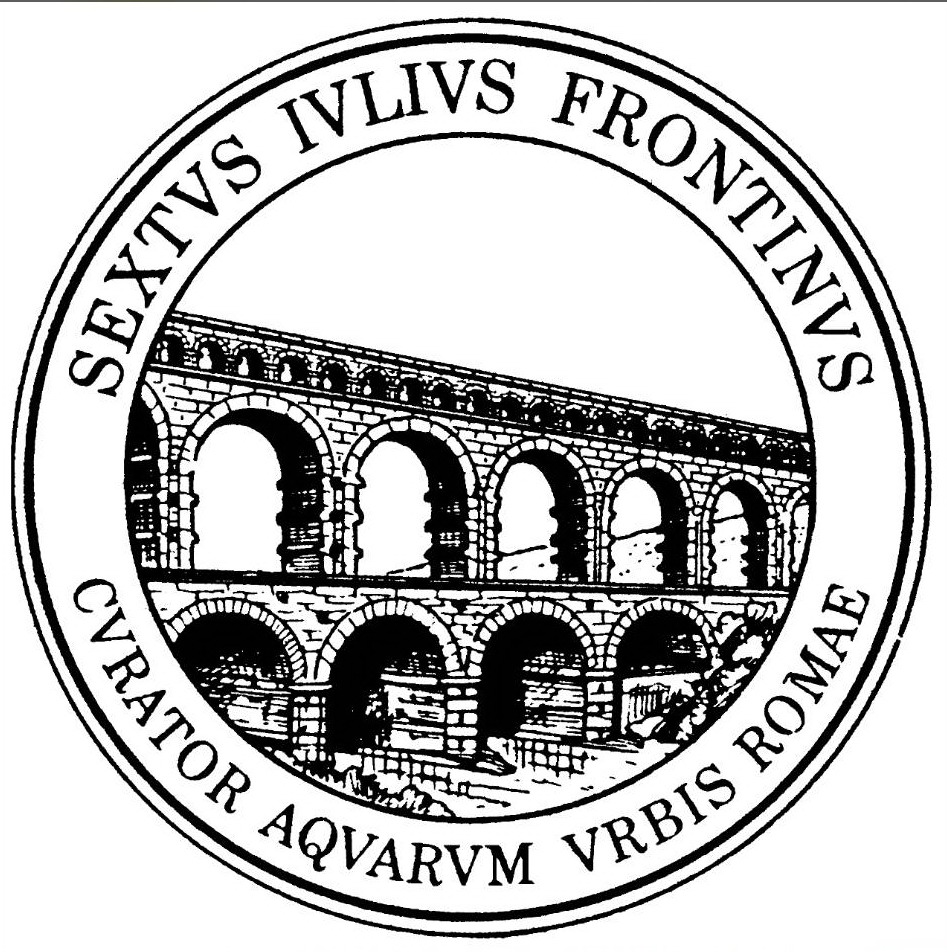
The general meeting of the Frontinus Society took place on
Saturday, July 11, 2020, 3 pm
as an online conference.
The protocol of the general meeting will be sent to the members soon.
Friday, 24.05.2019 until 26.05.2019
Frontinus-Excursion to Freiberg (Erzgebirge)
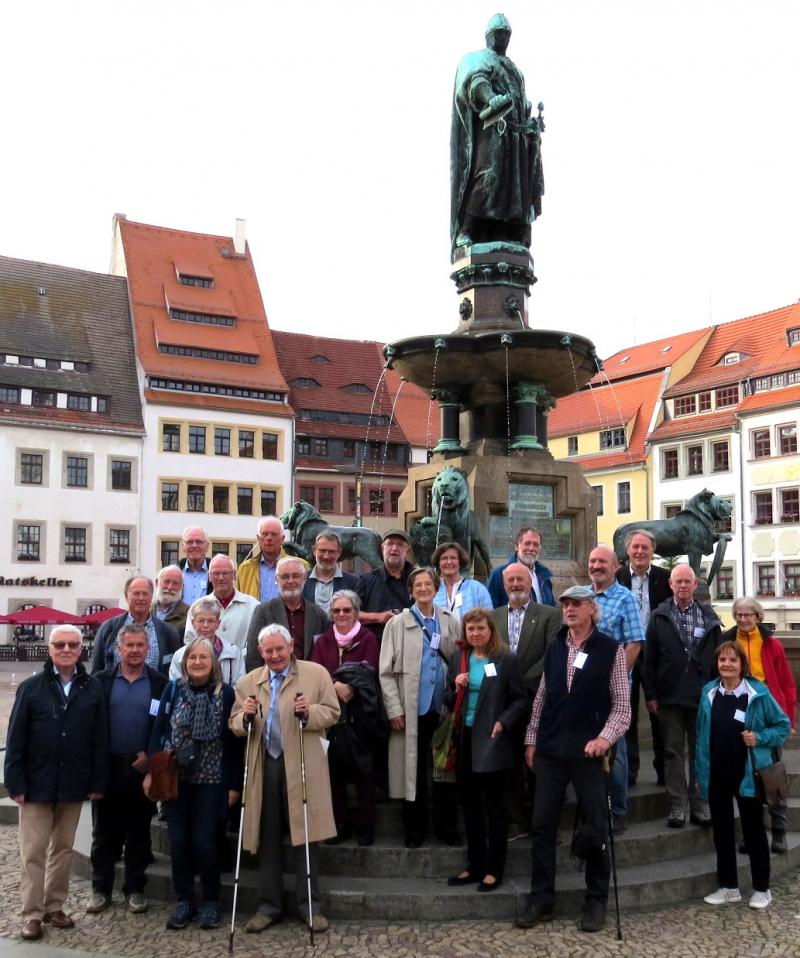
The Excursion to Freiberg includes visits to ancient mining and water facilities.
Saturday, 10.11.2018 until November 18, 2018
International Frontinus-Symposium in Rome
With 76 attendees from 15 countries this outstanding symposium was fully booked. The 34 lectures and 11 poster presentations gave a profound overlook on a wide spectrum of recent research and findings. The 7 days of the symposium encompassed also 8 excursions to many well preseved relicts of the aqueducts outside and inside of Rome and also to the most important urban baths and nymphaea. The highlight was the visit of the Villa Hadriani at Tivoli on the last day guided by Hubertus Manderscheid and Benedetta Adembri. The course of the symposium is available in the Program Symposium Rom 2018 .
A detailed report you find here .
Friday, 15.06.2018 until 16.06.2018
Excursion to Cologne
The annual technical-historical Frontinus excursion was organized by our member Prof. Dr. Klaus Grewe on June 15 and 16, 2018 and was very well received with 25 participants.
On Friday afternoon the destination of the visit was the so called Ubiermonument. Object and history of the watchtower, which is located at the southern end of the Roman harbour and later integrated into the city wall, were presented and explained by Dr. Alfred Schäfer from the Roman-Germanic Museum Cologne.
Dr. Thomas Höltken from the Roman-Germanic Museum in Cologne presented the extensive finds in the excavation area under the Cologne Cathedral. Dr. Gary White from the "Archaeological Zone Cologne" gave the technical explanations in the area of the Praetorium, which is also underground, and the sewerage system located there. Furthermore, both gentlemen gave information on current excavations and future plans. Read the report of Prof. Dr. Klaus Grewe here .
Friday, 08.09.2017 until 10.09.2017
Frontinus-Excursion to Salzburg
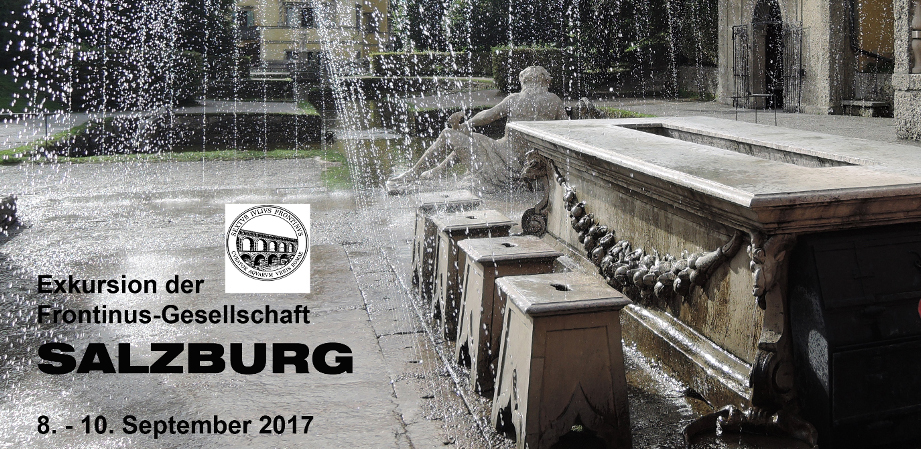
The Frontinus Society conducted an excursion to Salzburg from 8 to 10 September 2017. The highlight of the program was the ascent of the Almkanalstollen under the mountain "Mönchsberg". The Almkanal is a 12 km long, medieval water supply system from the 12th century, which was used to bring the water of the Lake Königsee to the cathedral chapter and Benedictine monastery of St. Peter in Salzburg and which was visited at several points during the excursion. Further sightseeing points were the evening visit to the illuminated fountains of Hellbrunn Palace. The cultural-geological city tour by Wolfgang Vetters from the University of Salzburg was the final part of the tour.
The excursion programme can be viewed here . Read the detailed report here .
Tuesday, 11.10.2016 to 12.10.2016
Frontinus-Excursion to Xanten
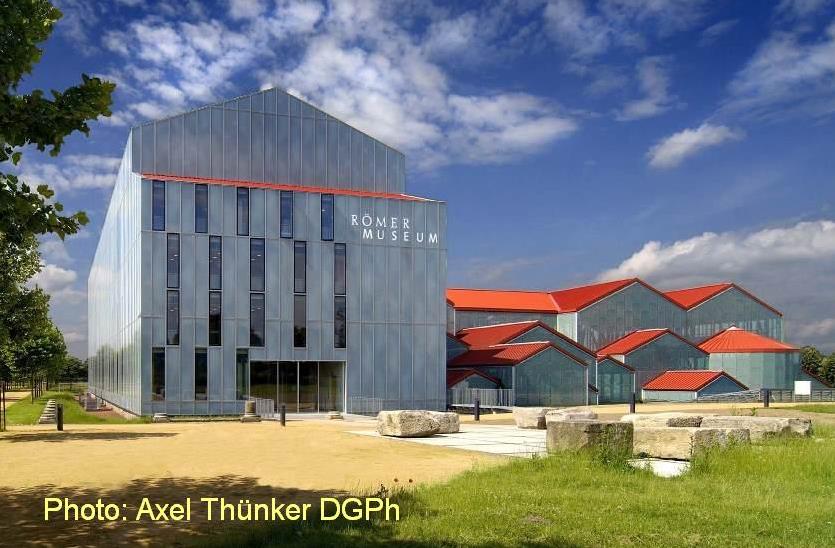
On 11 and 12 October 2016 the Frontinus Society organised a technical and historical excursion to Xanten.
The report about this excursion is available for download here .
During the excursion, Frontinus member Prof. Dr. Klaus Grewe guided through the exhibition "Aqueducts - Water for Rome's Cities", which he designed.
The
book
of the exhibition "Aqueducts - Water for Rome's Cities" is available from the secretariat
(
contact)
of the Frontinus Society.
Wednesday, 25.05.2016 until 29.05.2016
Anniversary Symposium of the Frontinus Society in Trier
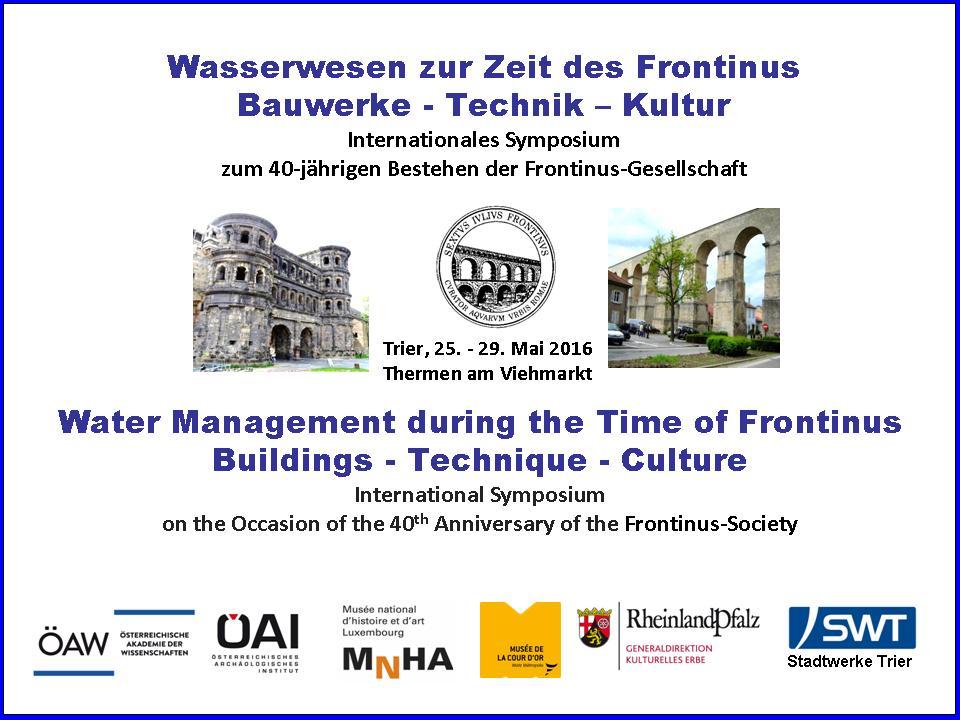
From 25 to 29 May 2016 the Frontinus Society celebrated its 40th anniversary with more than 80 participants from 15 countries at its international archaeological symposium: "Water Management durin the Time of Frontinus - Buildings - Rechnique - Culture" in Trier. The conference venue was the thermal baths built at the time of Frontinus at the Viehmarkt. In addition to the 12 lectures and 20 poster presentations on current topics, the region, which was important in Gallo-Roman times, was presented by excursions to Luxembourg and Metz, as well as visits to Trier.
Read the detailed report here .
In the review of the symposium you will find here . The proceedings have been published.
